Fantasy Books
Alien Ghostship - Book Review by Voodoo Bride
 Alien Ghostshipby Bella Blair
Alien Ghostshipby Bella BlairWhat is it about:Jane: While scouting my assigned sector in our galaxy, I come upon an abandoned alien ship. A Ghostship. Excited to explore the deserted vessel, things soon turn strange as an eerie mist follows me wherever I go, even showing me the way to a cabin that appears to have been left in a hurry. Soon I discover, that I'm not only unable to leave the Alien Ghostship, but I begin to dream of a handssome, alien stranger. Is he the guy who left this ship in an obvious haste?
WREN: Thanks to my copilot's betrayal, I have been a prisoner in this cave for I don't know how long. My only hope is that my prototype ship has left to find help, otherwise I'm afraid I will be doomed in here. One morning my tablet announces that somebody has boarded my ship. A woman of a species I have never seen before. Did she board my ship to steal it or to get help? And what is that mist that seems to follow her everywhere? And why do I suddenly begin dreaming of her? So real it is as if she were sitting right next to me. So alluring that all I care about is being with her.
What did Voodoo Bride think of it:I got this as a freebie for signing up to Bella Blair's newsletter
This is a nice read.
It could have used a bit more editing, but I liked the story well enough to overlook the typo's and missing words.
The romance is fast, but enjoyable. It is a bit of a puzzle how the two are noticing and feeling each other, but that added a bit of suspense to it.
The ending was a bit too obviously trying to shove in lead characters of other books, but all in all ths was a pleasant read. I got several other freebies for signing up, all part of different series by Blair. I might try one of those to see if there's a series/world that captures me.
Why should you read it:It's a nice SciFi Romance.
“Worms of the Earth” and Robert E. Howard’s Ultimate Triumph
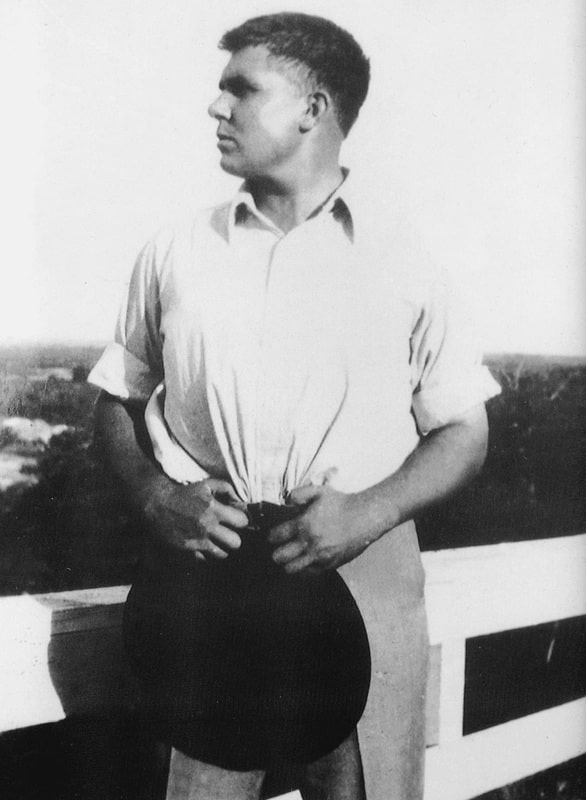
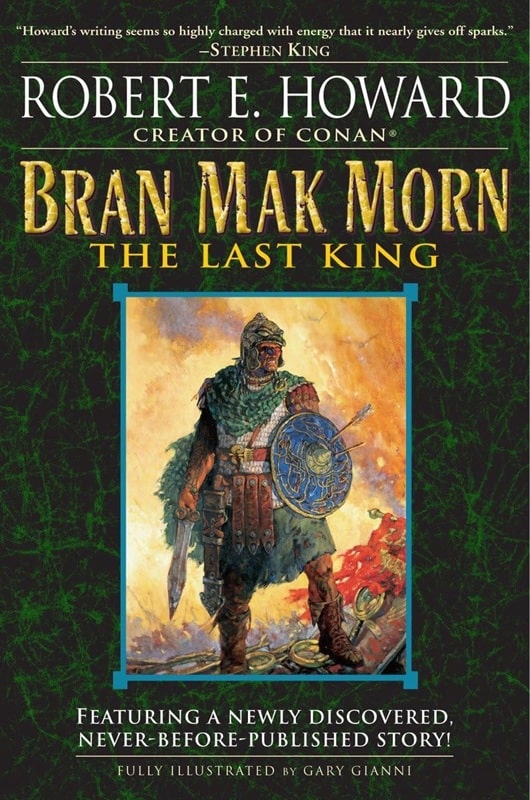
Robert E. Howard in a photo sent to H.P. Lovecraft in 1931,
and Bran Mak Morn: The Last King (Del Rey, May 31, 2005)
January 22, 2025 was the 119th birthday of Robert E. Howard, my favorite author. The works of this great author resonate with countless fans to this day.
“Worms of the Earth” is my favorite story by Robert E. Howard. It features Bran Mak Morn, the last king of the Picts.
Howard was fascinated with Picts, his conception of whom was largely mythological, with splashes of real world history. The Picts in his stories span Kull, Conan, Bran, James Allison, and more.
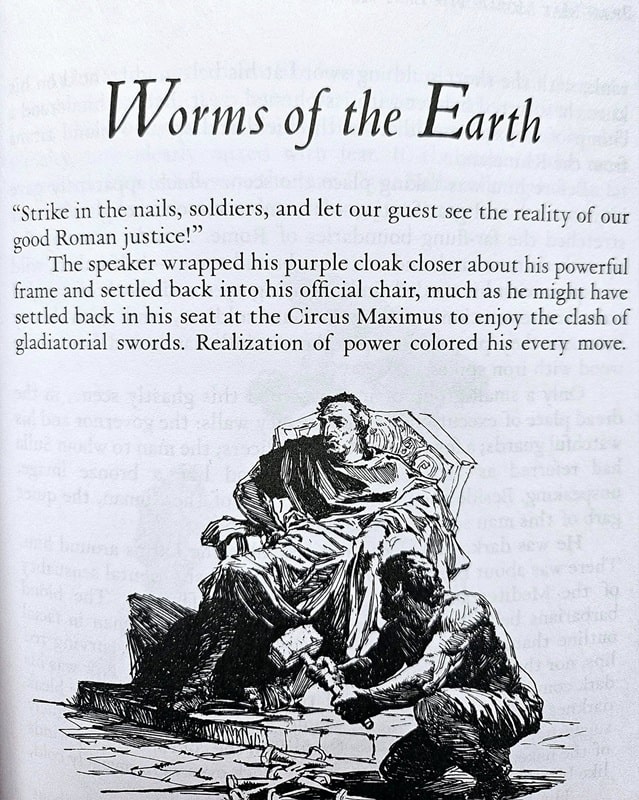
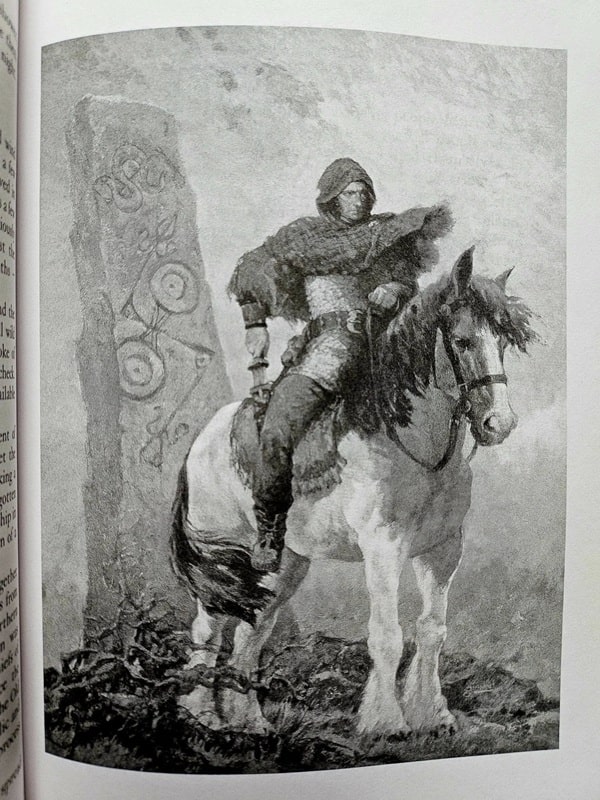
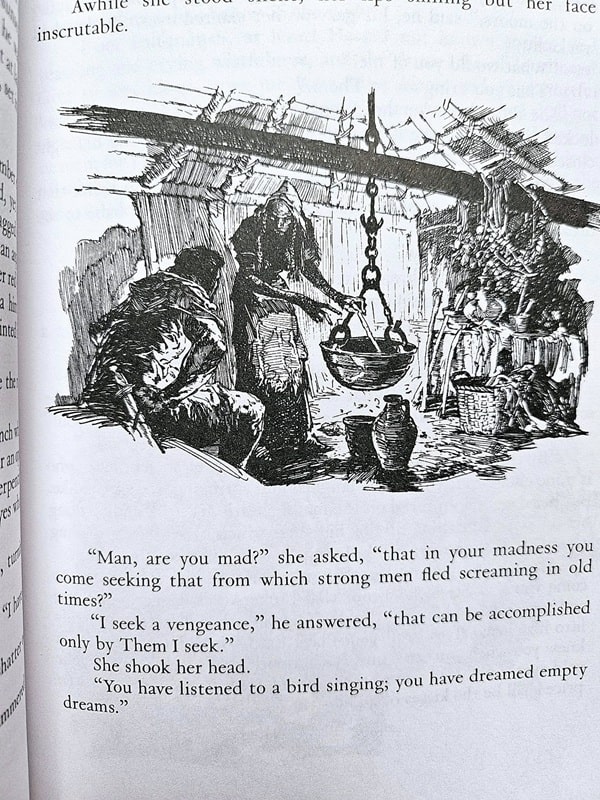
Art and layout from “The Worms in Earth,” published in
Bran Mak Morn: The Last King. Art by Gary Gianni
Of this story, REH said, “Only in my last Bran story, The Worms of the Earth… did I look through Pictish eyes, and speak with a Pictish tongue!”
The attached pictures feature art by Gary Gianni, from the Del Rey paperback, Bran Mak Morn, The Last King. His illustrations of the witch-woman, Atla, are particularly good.
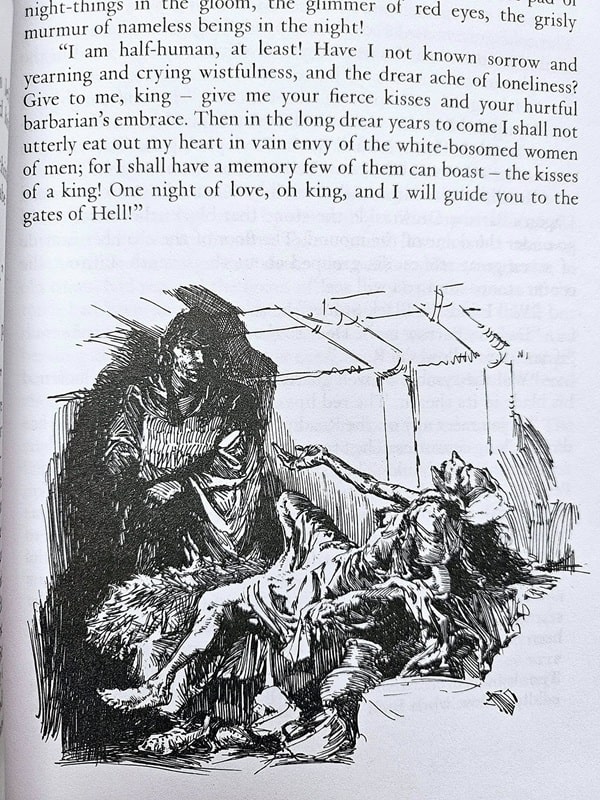
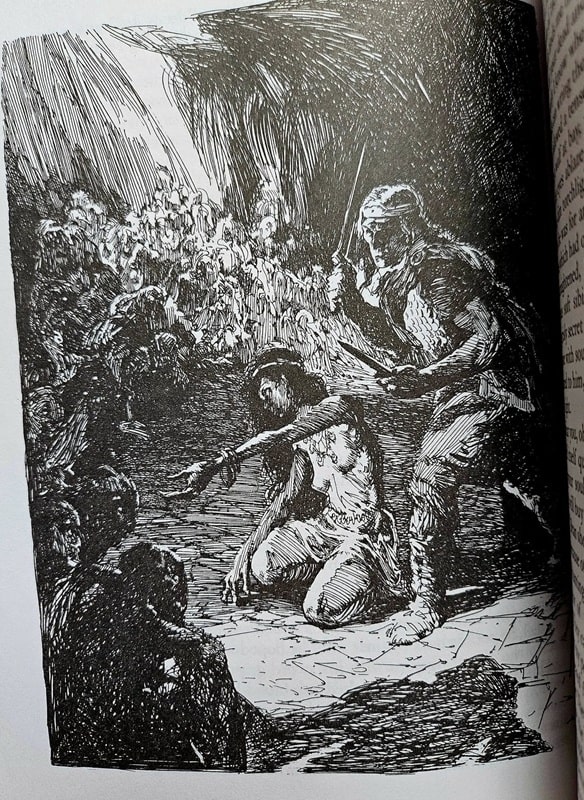
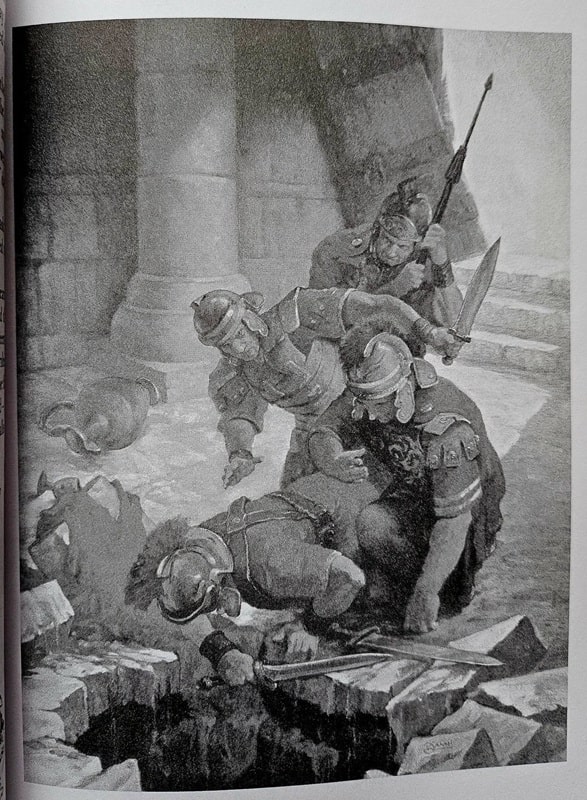
From “The Worms in Earth,” in Bran Mak Morn: The Last King
She was truly remarkable in the story, especially when she named her price for help to Bran:
What of my blasted and bitter life, I, whom mortal men loathe and fear? I have not known the love of men, the clasp of a strong arm, the sting of human kisses, I, Atla, the were-woman of the moors! What have I known but the lone winds of the fens, the dreary fire of cold sunsets, the whispering of the marsh grasses? – the faces that blink up at me in the waters of the meres, the foot-pad of night-things in the gloom, the glimmer of red eyes, the grisly murmur of nameless beings in the night!
I am half-human, at least! Have I not known sorrow and yearning and crying wistfulness, and the drear ache of loneliness? Give to me, king – give me your fierce kisses and your hurtful barbarian’s embrace. Then in the long drear years to come I shall not utterly eat out my heart in vain envy of the white-bosomed women of men; for I shall have a memory few of them can boast – the kisses of a king! One night of love, oh king, and I will guide you to the gates of Hell!
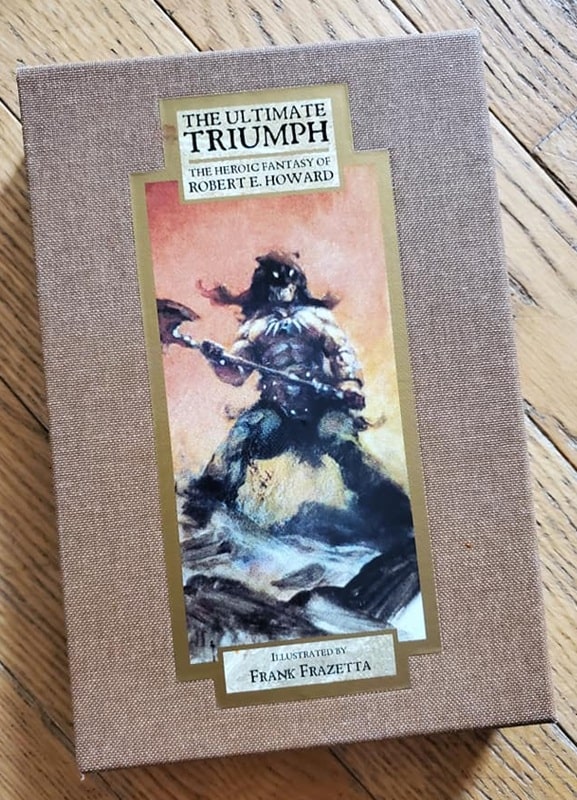
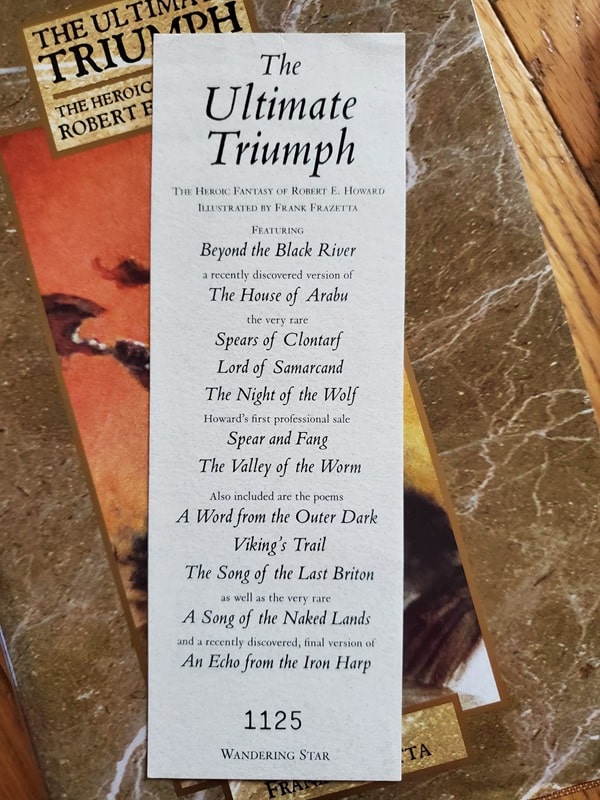
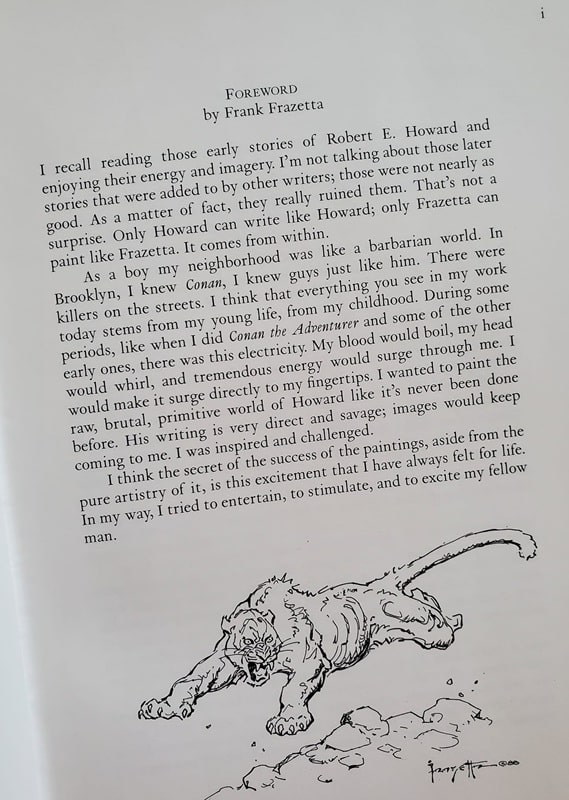
The Ultimate Triumph: The Heroic Fiction of Robert E. Howard
(Wandering Star, January 1, 1999). Art by Frank Frazetta.
The Ultimate Triumph ~ The Heroic Fiction of Robert E. Howard, illustrated by Frank Frazetta, is a prized treasure of mine, a gift that I received from my dear friend, Jim Goodwin.
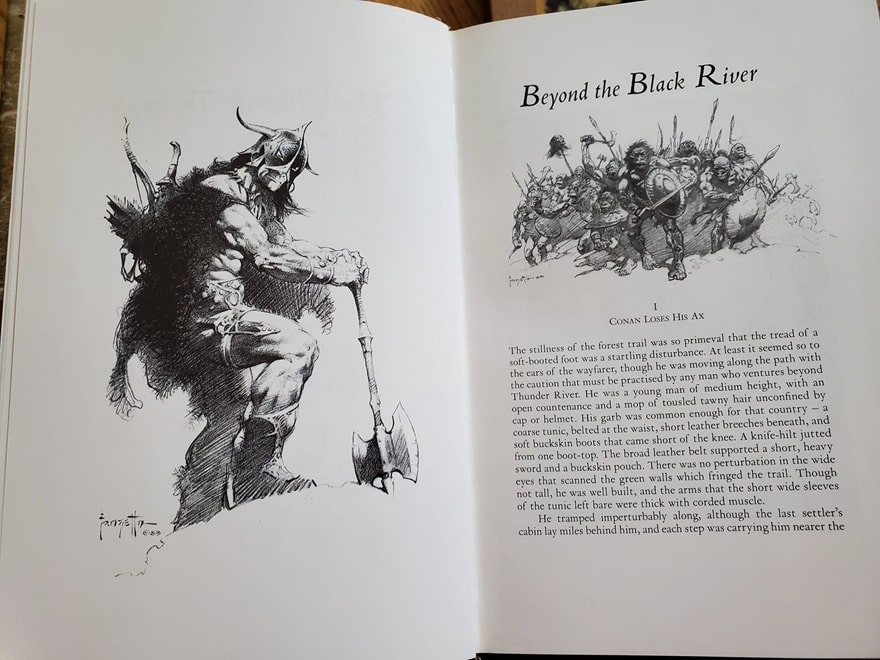 “Beyond the Black River,” in The Ultimate Triumph: The Heroic Fiction of Robert E. Howard. Art by Frazetta
“Beyond the Black River,” in The Ultimate Triumph: The Heroic Fiction of Robert E. Howard. Art by Frazetta
It features my favorite Conan story, “Beyond the Black River,” a recently discovered version of “The House of Arabu,” and several other rarities, poems, and one of my favorite letters that REH wrote to HPL regarding his stance on Civilization vs. Barbarism.
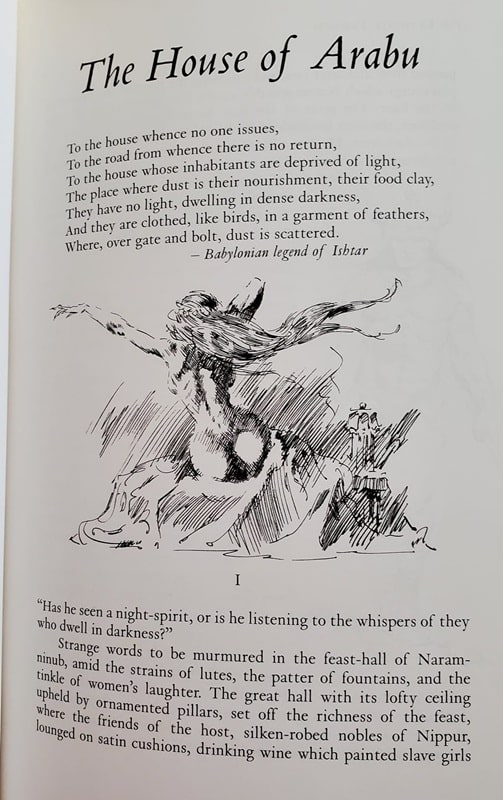
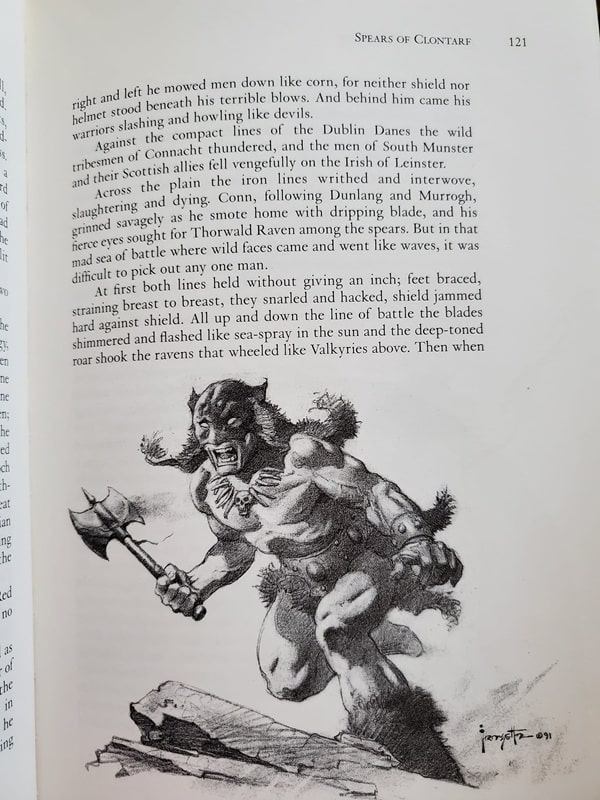
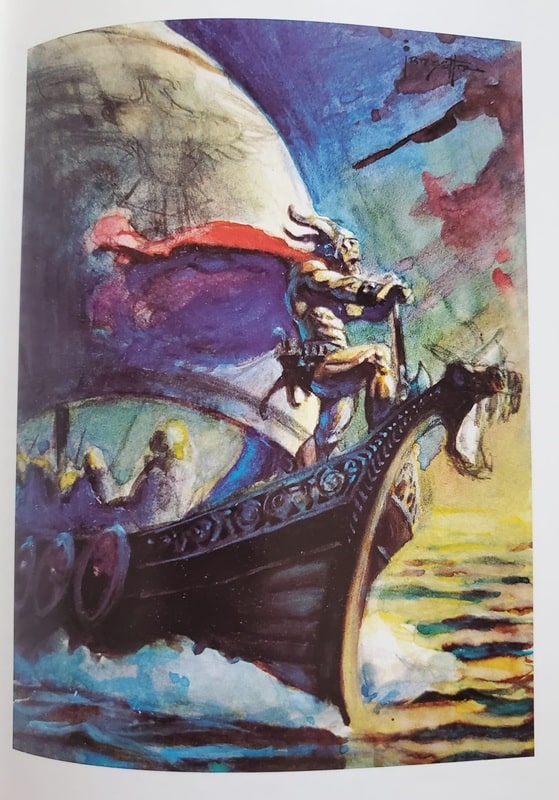
From The Ultimate Triumph: The Heroic Fiction of Robert E. Howard. Art by Frazetta
Sprinkled throughout this slipcased volume are incredible illustrations and paintings by the great Frank Frazetta. In fact, a foreword by Mr. Frazetta is also included, as well as an introduction by preeminent Howard scholar, Rusty Burke.
The title of this book is no misnomer, my friends — it truly is the ultimate triumph.
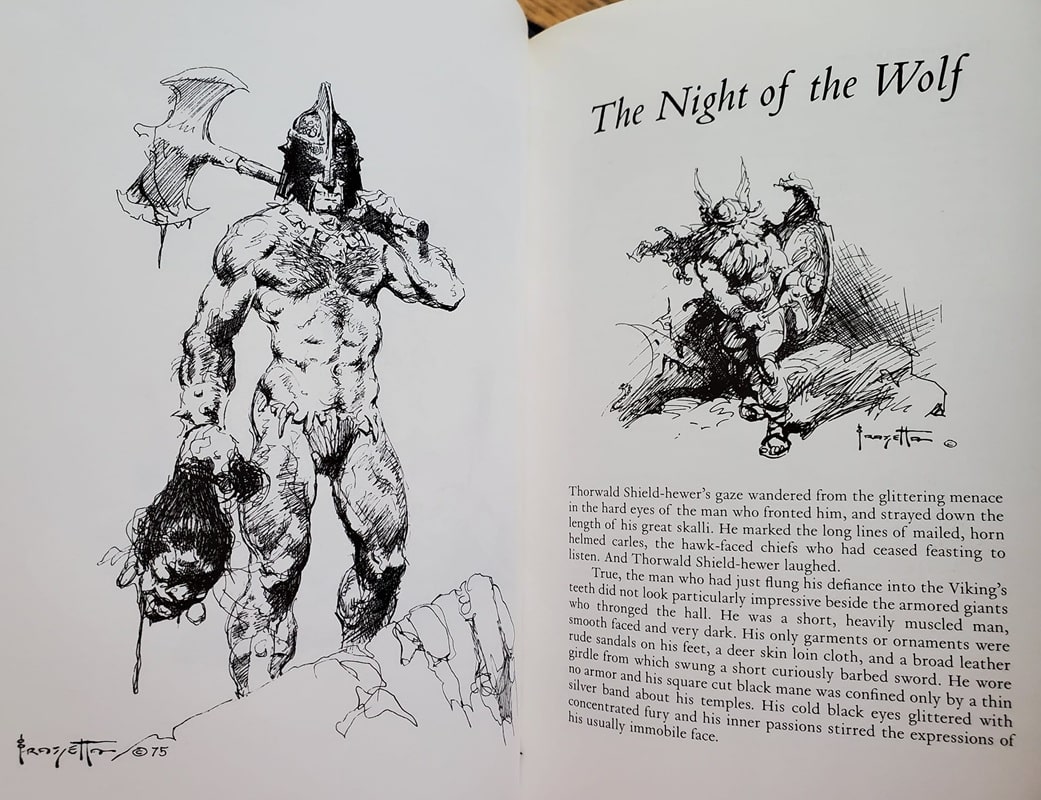
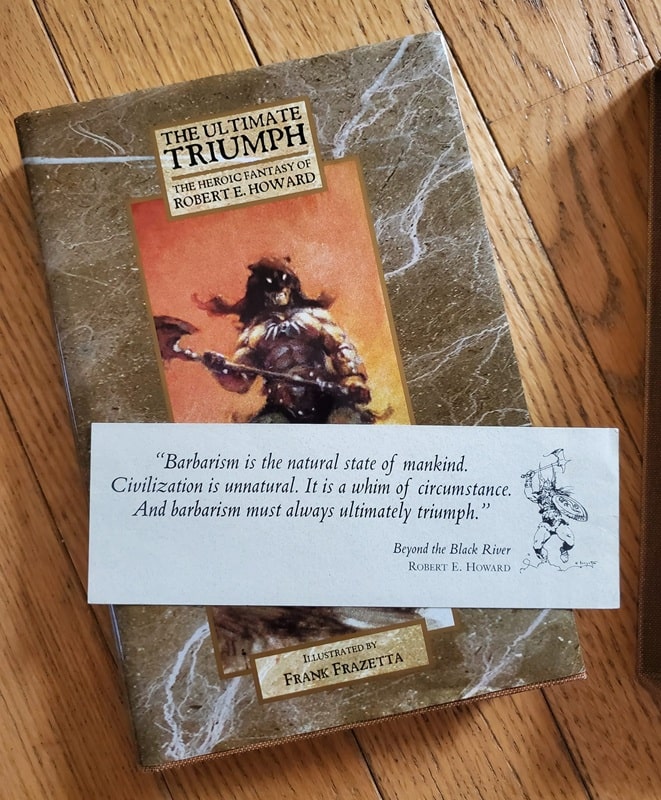
From The Ultimate Triumph: The Heroic Fiction of Robert E. Howard. Art by Frazetta
Robert E. Howard’s boxing stories may be his least read, because he’s so well known for Conan, Kull, Solomon Kane, Bran Mak Morn, El Borak, and several “Weird West” tales (a sub-genre that he is sometimes credited as the originator of).
But the boxing stories are excellent, too! They also include more humor than many of his other works (excepting the stories from A Gent from Bear Creek). Several of the “Sailor” Dennis Dorgan tales were not published during Robert’s lifetime, and those that were published were done so under his pseudonym, Patrick Ervin.
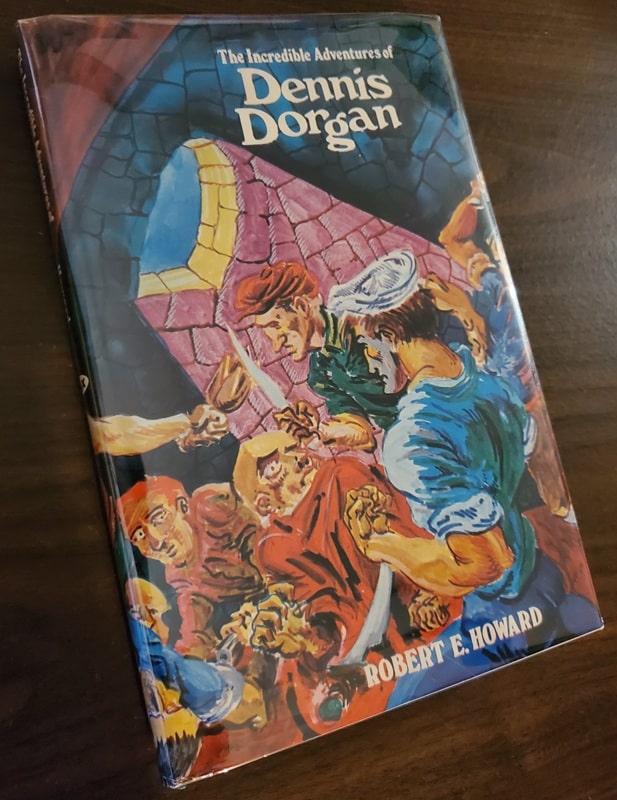 The Incredible Adventures of Dennis Dorgan (Fax Collector’s Editions, January 1, 1974))
The Incredible Adventures of Dennis Dorgan (Fax Collector’s Editions, January 1, 1974))
In December 2022 I received the download files for “The Black Stone,” by Robert E. Howard. This dramatic presentation, recorded by the inimitable H.P. Lovecraft Historical Society, may be (and please correct me if I’m wrong) the first time they have recorded an REH story. I couldn’t wait to listen to it! This is one of my favorite short stories.
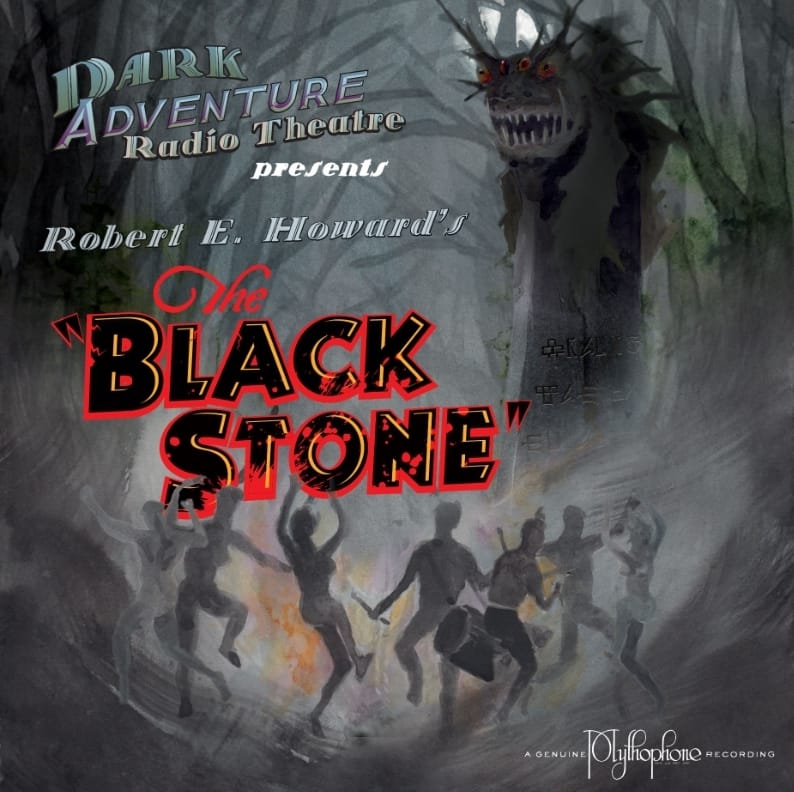 Robert E. Howard’s The Black Stone (H.P. Lovecraft Historical Society, December 2022)
Robert E. Howard’s The Black Stone (H.P. Lovecraft Historical Society, December 2022)
Robert E. Howard was an incredible innovator of sword-and-sorcery, weird fiction, horror, boxing, action/adventure, western, weird west stories, and more, as well as an equally impressive collection poems and verse. And he did almost all of it in a ten-year period from about age 20 to his passing at age 30, pounding away on an Underwood typewriter in a cramped, screened-in porch. I marvel at what he accomplished, and I wonder at what might have been.
If you are interested in the man and his life, I highly recommend Blood and Thunder, by Mark Finn.
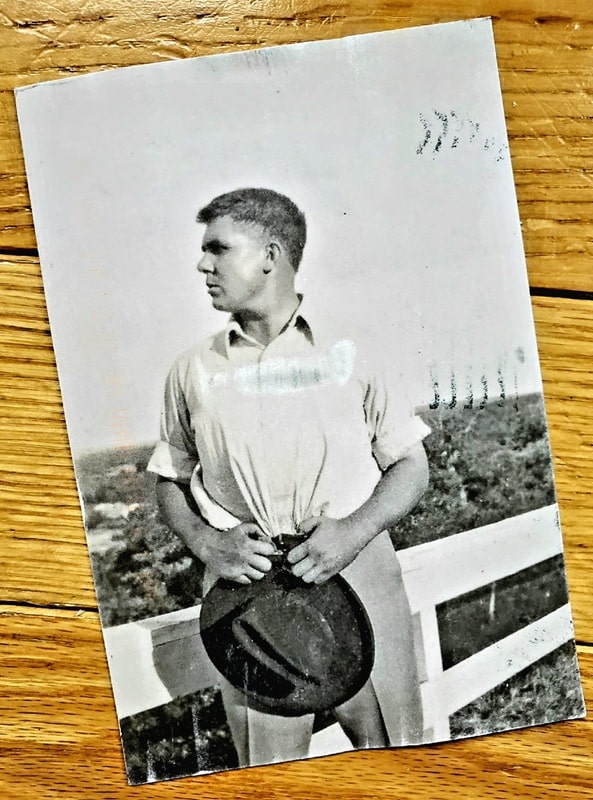
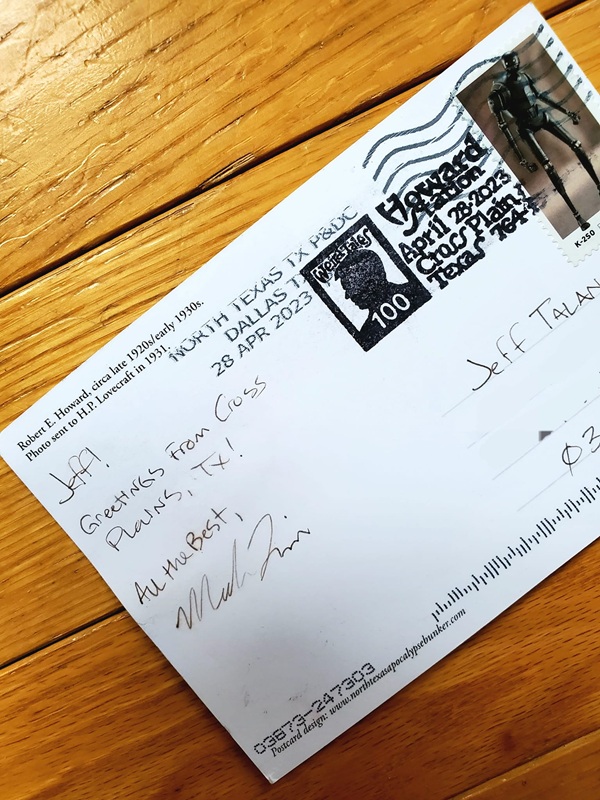
Robert E. Howard postcard
I never imagined that a postcard would be sent to me from Robert E. Howard’s home town of Cross Plains, TX. And during the 100-year anniversary of Weird Tales magazine, no less! I am ever grateful to my dog brother, Mark Finn, for making this possible.
I first met Mark after I’d read his stellar biography Blood & Thunder. I wanted to express my gratitude and appreciation for his incredible work, and I soon learned (surprise, surprise; or, “surprize,” as REH spelled it) that he was a fellow tabletop RPG enthusiast and comic book fan. So, thank you, Mark! By this postcard you rule!
Jeffrey P. Talanian’s last article for Black Gate was a review of The Eye of Sounnu by Schuyler Hernstrom. He is the creator and publisher of the Hyperborea sword-and-sorcery and weird science-fantasy RPG from North Wind Adventures. He was the co-author, with E. Gary Gygax, of the Castle Zagyg releases, including several Yggsburgh city supplements, Castle Zagyg: The East Mark Gazetteer, and Castle Zagyg: The Upper Works. Read Gabe Gybing’s interview with Jeffrey here, and follow his latest projects on Facebook and at www.hyperborea.tv.
Teaser Tuesdays - What Moves the Dead
Doing a reread of this book before reading What Feasts at Night.

The mushroom's gills were the deep-red color of severed muscle, the almost-violet shade that contrasts so dreadfully with the pale pink of viscera. I had seen it any number of times in dead deer and dying soldiers, but it startled me to see it here.
(page 1, What Moves the Dead by T. Kingfisher)
---------
Teaser Tuesdays is a weekly bookish meme, previously hosted by MizB of Should Be Reading. Anyone can play along! Just do the following: - Grab your current read - Open to a random page - Share two (2) “teaser” sentences from somewhere on that page BE CAREFUL NOT TO INCLUDE SPOILERS! (make sure that what you share doesn’t give too much away! You don’t want to ruin the book for others!) - Share the title & author, too, so that other TT participants can add the book to their TBR Lists if they like your teasers!
THE RADIANT KING by David Dalglish (Astral Kingdoms, 1)
Book Review: The Third Rule of Time Travel by Philip Fracassi
I received a review copy from the publisher. This does not affect the contents of my review and all opinions are my own.
 The Third Rule of Time Travel by Philip Fracassi
The Third Rule of Time Travel by Philip Fracassi
Mogsy’s Rating: 4 of 5 stars
Genre: Science Fiction
Series: Stand Alone
Publisher: Orbit (March 18, 2025)
Length: 325 pages
Author Information: Website
Time travel in science fiction has always been a fascinating yet challenging concept, teasing stories with endless potential while bringing its own unique set of headaches. Taking a bold step into this tricky domain of complex timelines and tangled paradoxes, Philip Fracassi brings us The Third Rule of Time Travel, a novel where the weight of memory and grief takes center stage.
The novel follows scientist Dr. Beth Darlow, who along with her late husband Colson had been developing a machine that allows the transport of the human consciousness through time and space. However, this form of time travel has limits. First, you can only travel within your own lifetime, so forget about going back to the dinosaurs or witnessing the fall of Rome. Second, there is no reliable way to know when and where your consciousness will end up, only that it can travel for no more than ninety seconds. Third, over the course of these ninety seconds, no interaction is possible, only observation. Due to the restraints on this particular tech, these three rules are immutable, with many mechanisms put in place to ensure that sending an individual’s consciousness to the past should not alter the present.
In the aftermath of Colson’s death, Beth is left to raise their young daughter on her own. She throws herself into her work, using the time machine to gather more data. But as the pressure mounts, her trips into the past become increasingly dangerous, with the machine seemingly to force her to relive her most traumatic moments. For Beth, whose life has been marked by plenty of grief—including the tragic loss of her parents and older sister in a plane crash during a childhood vacation, and Colson’s fatal car accident on her last her birthday—these painful memories threaten to shatter her. Then, a disturbing anomaly arises in the form of a discrepancy discovered between reality and the failsafe method designed to monitor changes in the present timeline. As the line between what is real and what is not begins to blur, Beth must do everything she can to hold onto her loved ones and her legacy.
Fracassi’s storytelling in The Third Rule of Time Travel is a riveting mix of fast-paced action punctuated by poignant, emotional beats. Tragedy has followed Beth since she was a kid, and the novel kicks off with a harrowing opening sequence, putting us in her head as her consciousness is transported to the worst moment of her life, as a way to introduce its time traveling elements. From this point onwards, the plot maintains strong momentum, keeping the interest going by making the reader care about Beth’s personal and professional life. The cutting-edge descriptions of the story’s time traveling method alongside the top-secret nature of the character’s work made it easy to keep turning the pages.
When it comes to characterization, Beth Darlow is a layered and sympathetic protagonist whose strength lies in her determination to keep living despite the recent loss of her husband, juggling both the important roles of scientist and now single mom. At home, she struggles with the guilt of hiring a nanny and having less time to spend with her daughter, while at work she seems to be constantly fighting time and funding constraints placed upon her by the company’s higher ups. But while this is undeniably Beth’s story, I feel that some of the supporting characters—the best friend, the research partner, the hard-ass boss, etc.—could have been better fleshed out to give the novel’s premise a more convincing boost.
There are also moments where this book stumbles under the weight of too much exposition, though going back to the complexities of time travel, I suppose a certain amount of info-dumping is to be expected. Most of these sections were thankfully brief and didn’t affect the pacing too much, and to his credit, Fracassi managed to get a lot of detail and explanation across without making it boring. Ultimately, the unique “three strict rules” imposed upon the author’s version of time traveling resulted in a thought-provoking read, emphasizing the psychological impotence one must experience when reliving a terrible life event with no power to change its course. That said, as is often the case with time travel stories, I didn’t feel like it stuck the landing. The climax and the ensuing confusion almost seemed intentional, as if discouraging you from overanalyzing and asking questions.
Still, at the end of the day, The Third Rule of Time Travel is a fresh and ambitious novel whose risks largely paid off. Despite a few minor stumbles here and there, the story managed to avoid major pitfalls that tend to plague hard science fiction time travel narratives—namely, the type of overly complicated or excessive minutiae that causes much frustration to readers. Overall, it was a worthwhile read that mades me appreciate the subgenre.
![]()
![]()
Monday Musings: My Big Brother
People often ask why Nancy and I moved to New York when we left the Appalachians. We could have settled pretty much anywhere, but we chose an area — the Hudson River Valley — that few think of as a retirement destination. The fact is, a main reason we came here was to be near my brother and sister-in-law, whom we adore.
 Jim and me, birding in Arizona.
Jim and me, birding in Arizona.
As it happens, this is my brother’s birthday week, and so I am afforded a wonderful opportunity to embarrass him.
James Coe — Jim to me; Jimmy when we were much younger — is just about my very favorite person in the world. He is older than I am. I won’t say by how much, but trust me, it’s A LOT!! When we were kids, I wanted to do everything he did, often to his dismay. He was my babysitter, my early-life mentor, occasionally my tormentor, but throughout all my years my best friend. He was the one who interested me (and our oldest brother, Bill) in birdwatching. He shaped my early musical tastes, introducing me to James Taylor, Joni Mitchell, the Beatles, Crosby Stills and Nash, Carole King, Simon and Garfunkel, not to mention the Monkees and Young Rascals. Later, as I got older, he was my guide to jazz. He saw to it that I discovered pizza. He risked parental sanction by lighting off firecrackers for my entertainment (and the satisfaction of his own pronounced pyromaniacal tendencies).
Jim is a remarkably talented artist — you can find samples of his work, as well as his very impressive biography, here — and all kidding aside, his courage in pursuing his own unconventional artistic career emboldened me to do something similar in pursuit of my passion for writing fantasy. In a sense, I owe my career to his example. His art is all over our walls, and for all of my adult life, the best gift I could receive for any birthday has been an original James Coe painting. Over the years, he has been incredibly generous in that regard.
He is a bold and creative chef, an accomplished baker whose from-scratch bread rivals Nancy’s (and that, my friends, is saying something). He is wise and caring, a wonderful Dad to his talented, beautiful children, Jonah and Rachel, a loving spouse to his spectacularly brilliant wife, Karen, and a marvelous uncle to our girls. He is, to this day, my favorite birding companion, my constant partner in silliness, my beloved big brother.
So, please wish Jim a happy birthday, and really do check out his website. He is annoyingly talented.
Love you, Coe.
Spotlight on “Gifted and Talented” by Olivie Blake
In Gifted and Talented, three siblings are forced to reckon with their long-festering rivalries, dangerous…
The post Spotlight on “Gifted and Talented” by Olivie Blake appeared first on LitStack.
Was Don Newcombe a Hall of Famer? – Spring means Baseball
 I have occasionally strayed off topic here at Black Gate, KISS, the Beach Boys, Humphrey Bogart…stuff like that. I played tee-ball as a tyke and have loved baseball my whole life. With a new season dawning (one in which my beloved Dodgers are the reigning World Series champs for the fourth time since I was born), I wanted to talk baseball. And I think that sharing about Don Newcombe is the way to do it.
I have occasionally strayed off topic here at Black Gate, KISS, the Beach Boys, Humphrey Bogart…stuff like that. I played tee-ball as a tyke and have loved baseball my whole life. With a new season dawning (one in which my beloved Dodgers are the reigning World Series champs for the fourth time since I was born), I wanted to talk baseball. And I think that sharing about Don Newcombe is the way to do it.
In 1949’s (sappy) It Happens Every Spring, Ray Milland’s chemistry professor suffers through his life half of the year, to get to baseball season.
Lord Tenneyson said ‘In the Spring a young man’s fancy lightly turns to thoughts of love.’ For a long time, it was baseball, not love, that young men thought of in American Spring.
When Spring Training would roll around in Florida (and then later, also in Arizona), I used to say “If they’re playing baseball somewhere, there’s till some hope for the world.” I’m not sure I believe that in these messed-up days. But the Dodgers (the epitome of a small-market, hard-working franchise, competing against big city, big money teams – HA HA HA) are working out and playing games in Arizona. It’s baseball season, which helps me ignore that my Ohio wind chill is 15 degrees right now.
The Dodgers and Yankees met in the World Series in 1947, 1949, 1952, 1953, 1955 and 1956. It was a glorious era for NYC baseball (and the Giants were a powerhouse as well), though Brooklyn managed to win only the 1955 matchup.
The greatest advantage that the Yankees had was their starting pitching. Whether it was Eddie Lopat, Allie Reynolds, Whitey Ford, Bob Kuzava or Don Larsen, the Bronx Bombers always seemed to come up with somebody in big moments (if not for Cookie Lavagetto, Bill Bevens would be included on that list).
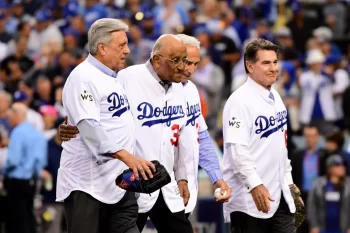 Rick Monday, Newcombe, Sandy Koufax, and Steve Garvey
Rick Monday, Newcombe, Sandy Koufax, and Steve Garvey
During this era, Don Newcombe rose above other Dodger would-be aces such as Carl Erskine, Ralph Branca and Johnny Podres (though the latter certainly carried the flag in the 1955 Series). Big Newk missed the 1952 and 1953 seasons, as he was serving his country, fighting in Korea. And his 1954 season was a poor one: it took him a year to get back to form after being released from service.
But from 1949-1951 and 1955-1956, Newcombe went a combined 103-40, with 92 complete games. Those are some impressive numbers for the 1949 Rookie of the Year.
However, he got a reputation as a choker in big games. He went all ten innings against the Phillies on the final day of the 1950 season, with the Dodgers needing a win to force a playoff. But he gave up a three run homer to Dick Sisler in the top of the tenth in the season-ending 4-1 loss (which would have been a win if third base coach Milt Stock had simply held Cal Abrams at third in the bottom of the ninth).
He carried a 4-1 lead into the ninth inning of that famous game three playoff against the Giants in 1951. But he couldn’t hold on and he had been relieved by Ralph Branca when Bobby Thomson hit the home run heard round the world.
And in three World Series’, he just couldn’t get the job done for the Dodgers. He started 5 games, going 0-4 with an ERA of 8.59 and lasting about 4 innings a start. Dominating regular season, poor post-season: Shades of a great lefty named Clayton Kershaw, several decades and thousands of miles West, later (Kershaw is my second-favorite Dodger, after Jackie Robinson).
In 1956, he won the (very first) Cy Young Award and the NL MVP, going 27-7. But in the World Series he couldn’t make it out of the second inning of game two or the fourth in game seven. His drinking more directly impacting his performance, as well as his shoulder wearing out from the overuse, his career was effectively done, and he went a combined 37-42 in the four years after that Cy Young season.
He spent 1961 in the minors and he finished in Japan in 1962, as a first baseman. Newcombe was a career.268 batter, with 7 homers in 1955. He could have been a major league hitter.
A Trailblazer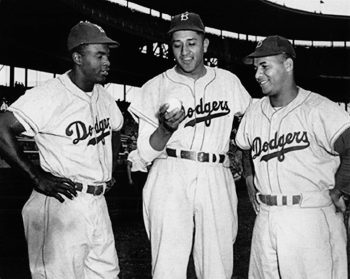 Newcombe was one of the first black players signed by the Dodgers. He and Roy Campanella played with Nashua of the New England League (B) in 1946. Newcombe returned there in 1947 (striking out 186), while Campanella played at AAA Montreal, and Jackie Robinson changed the world in Brooklyn.
Newcombe was one of the first black players signed by the Dodgers. He and Roy Campanella played with Nashua of the New England League (B) in 1946. Newcombe returned there in 1947 (striking out 186), while Campanella played at AAA Montreal, and Jackie Robinson changed the world in Brooklyn.
Newcombe was dominant in his two years at Nashua, going 33-10 with an ERA well under 3. He probably would have played in AA ball in 1947 but the Dodgers’ two AA teams were in the South and not yet ready to be integrated. Apparently AAA wasn’t the best option, as it had been for Robinson and Campanella.
In 1948 he went 17-6 at AAA Montreal (while Campy began his Hall of Fame career in Brooklyn). He threw his only no hitter, won three games in the first round of the International League Playoffs (losing another game 0-1), and then won a game in the Governor’s Cup series. He then went 1-1 as the Royals defeated the Dodgers’ other AAA team (St. Paul) for the Junior World Series. Newcombe dominated AAA.
He got called up to the Dodgers early in 1949. He was only the second black pitcher in the major leagues and the first good one (Dan Bankhead pitched in four games for the Dodgers in 1947).
Jackie Robinson deserves every praise and accolade. But Don Newcombe was the first man to prove an African-American could pitch in the major leagues. He hit 3 batters as a rookie, and 6 his third year. But there were no racial issues about a black pitcher hitting a white batter. It didn’t hurt that he was 6’-4”, 220. But his success, and his acceptance on the field, made him a pioneer, though he never received the credit he deserved for that.
Close to Cooperstown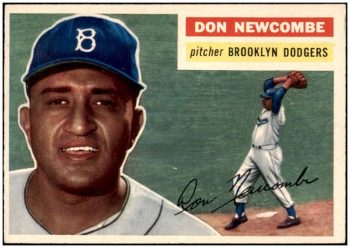 His raw numbers are lacking in HoF dazzle: 153-96, with a 3.57 ERA.
His raw numbers are lacking in HoF dazzle: 153-96, with a 3.57 ERA.
He does have one Rookie of the Year, one MVP, and one Cy Young award, along with one World Series ring, and he was a four-time All Star. That’s what is. But we can also look at a few ‘What ifs.’
There are four distinct elements of his career that might have changed his possible Hall of Fame path:
1) Newcombe’s first two seasons were spent with the Newark Eagles in the Negro Leagues. It’s fair to say that he might have developed more quickly with two years in the Dodgers’ system. But he was only 18 that first year. Maybe the hard experience of playing in the Negro Leagues had some benefits for him.
2) He lost a season, maybe two, to baseball’s color barrier. It’s a foregone conclusion that he would have done better than Dan Bankhead did. He was 17-8 with 19 complete games and a league-leading 5 shutouts as a 23 year-old rookie. That’s a pretty good start.
3) And he lost nearly two peak seasons to the Korean War. Plus his first year back was basically a lost one as well. He easily could have had three more 20 win/single-digit loss seasons.
Give him 60 more wins for the Korean War years, and there would be a dozen pitchers with fewer wins who are in the Hall of Fame, including two Dodgers (Don Drysdale, Dazzy Vance).
4) Finally, had Newcombe pitched better in the World Series (especially in 1956), he might well have continued on as one of the NL’s top pitchers, instead of spiraling deep into alcoholism.
With two more outs, it’s Newcombe, not Bobby Thomson, who is the hero of the 1951 NL playoff series (playoffs only occurred if two teams were tied at the end of the season. MLB did not adopt divisions and regular playoffs until 1969).
And with post-season success, the media might have lightened up (racism was certainly involved, but everyone loves a winner – somewhat). And he might have been more at ease if he wasn’t so clenched up inside from the criticism (Conversely, Newcombe was not appropriately praised for when he excelled, which he often did.).
That fourth factor (the postseason) was certainly within his control. But if the first three things had gone a bit differently, Don Newcombe might well be in the Hall of Fame today.
He and Justin Verlander are the only players to win the Rookie of the Year, Cy Young and MVP awards. That speaks volumes.
He Was Criticized Unjustly in the Press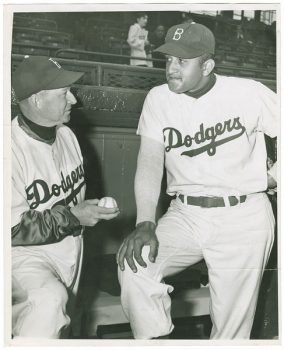 If you’ve read books about Jackie Robinson, you know the abuse that racist sportswriters (and fans, and players, and…) heaped upon him. Other early trailblazers like Newcombe were also the subject of vitriol. On September 14, 1951, Tommy Holmes of the Brooklyn Eagle – under the headline Is Newcombe Ailment a Case of Imaginatis? – wrote a scathing, rumor and innuendo-filled attack on Newcombe, which never would have been written about a white pitcher. Excerpts can be found in Jon Weisman’s book on Dodgers pitching, Brother in Arms. It’s a pathetic piece of non-objective ‘journalism’.
If you’ve read books about Jackie Robinson, you know the abuse that racist sportswriters (and fans, and players, and…) heaped upon him. Other early trailblazers like Newcombe were also the subject of vitriol. On September 14, 1951, Tommy Holmes of the Brooklyn Eagle – under the headline Is Newcombe Ailment a Case of Imaginatis? – wrote a scathing, rumor and innuendo-filled attack on Newcombe, which never would have been written about a white pitcher. Excerpts can be found in Jon Weisman’s book on Dodgers pitching, Brother in Arms. It’s a pathetic piece of non-objective ‘journalism’.
For example, Holmes asserts that ‘experts’ expected Newcombe to win 30 games that season, and instead of doing so, he was complaining about a sore arm. Dizzy Dean won 30 games in 1934. Exactly one pitcher has done so (that’s a good trivia question – go look it up) in the 90 seasons since. Holmes wrote an ‘uppity negro’ piece on Newcombe, and it was wrong in EVERY way.
As Chuck Dressen desperately tried to stop the Dodgers’ epic collapse (they led by 13 games in August), he kept throwing a tired (Newk led the team in innings pitched and had 18 complete games) and sore-armed Newcombe out there.
Newcombe started on September 17th, lasting only 6 and two-thirds. On the 22nd, he only made it 5 innings. On the 26h, he threw a complete game in a 15-5 win (you think Dressen couldn’t have given him a few innings off in a ten run win?). Only three days later on the 29th, it was a complete game shutout. And the very next day in the must-win season-finale, Dressen had him pitch 5 and two-thirds innings of relief. Big Newk gave up one hit and no runs as the Dodgers won 9-8, forcing the three-game playoff that made Bobby Thomson a baseball legend.
On only two days rest, after that heavy workload, Newcombe pitched 8 and one-third innings in that third-game loss. He had performed an even more impressive feat of carrying the team to the final day of the season the year before.
Holmes and other writers (and NYC baseball writers were celebrities in their day) wrote about Newcombe from their racist beliefs, not as objective observers. He was a workhorse who carried Dodgers teams to the brink of championships.
Alcoholism and RebirthNewcombe succumbed to life-long alcoholism. While he made the choice to drink, the unrelenting (and unreasonable) pressure he was subjected to, along with racist abuse, surely contributed to its severity. He declared bankruptcy in 1965 (he sold his World Series ring, which future Dodgers owner Peter O’Malley later bought and returned to him), and later divorced.
But he stopped drinking, straightened out his life, and was the Dodgers’ Director of Community Relations for over forty-five years, passing away in 2019. He became a leader in several organizations inside and outside of baseball, related to beating alcoholism.
Newcombe reflected on his career being cut short:
“I was only 34, but the alcohol had taken its toll. I think it shortened my major-league career by about six or seven years. I regret that I didn’t take better care of myself in the latter part of my career because I would like to have made the Hall of Fame, where I think I belong.”
Don Newcombe was haunted by his own demons, but found his own personal redemption. And with better handling on the Dodgers’ part; a few more seasons in the majors; and some more self-control, he could well be in Cooperstown today.
Newcombe recounted a conversation he had with Martin Luther King Jr.:
“Do you want to know what Jackie’s impact was? Well, let Martin Luther King tell you. In 1968, Martin had dinner in my house with my family. This was 28 days before he was assassinated. He said to me, ‘Don, I don’t know what I would have done without you guys setting up the minds for people for change. You, Jackie (Robinson) and Roy (Campanella) will never know how easy you made it for me to do my job.’ Can you imagine that? How easy we made it for Martin Luther King?”
He was an under-appreciated trailblazer, who rewrote his own personal story and played a major part in Dodgers’ history, on and off the field. And he wasn’t as far from a Hall of Fame career as one might think. It’s a shame no one worked with him to write a biography. It would have been a terrific book. He passed in 2019.

Bob Byrne’s ‘A (Black) Gat in the Hand’ made its Black Gate debut in 2018 and has returned every summer since.
His ‘The Public Life of Sherlock Holmes’ column ran every Monday morning at Black Gate from March, 2014 through March, 2017. And he irregularly posts on Rex Stout’s gargantuan detective in ‘Nero Wolfe’s Brownstone.’ He is a member of the Praed Street Irregulars, founded www.SolarPons.com (the only website dedicated to the ‘Sherlock Holmes of Praed Street’).
He organized Black Gate’s award-nominated ‘Discovering Robert E. Howard’ series, as well as the award-winning ‘Hither Came Conan’ series. Which is now part of THE Definitive guide to Conan. He also organized 2023’s ‘Talking Tolkien.’
He has contributed stories to The MX Book of New Sherlock Holmes Stories — Parts III, IV, V, VI, XXI, and XXXIII.
He has written introductions for Steeger Books, and appeared in several magazines, including Black Mask, Sherlock Holmes Mystery Magazine, The Strand Magazine, and Sherlock Magazine.
Review: The Raven Scholar by Antonia Hodgson

FORMAT/INFO: The Raven Scholar will be published on April 15th, 2025 by Orbit Books. It will be available in paperback, ebook, and audiobook formats.
OVERVIEW/ANALYSIS: Every 24 years, seven contenders from seven warrior temples match wits and blades in a series of trials designed to pick the next emperor of Orrun. It's a tradition that has largely ensured a peaceful transition of power for over 1500 years. But this year, one of the contestants is murdered on the eve of the competition. High Scholar Neema Kraa is charged with solving the murder, plunging her into a web of palace secrets. It isn't long before Neema realizes that people will kill to keep their secrets - and the only path to survival might be becoming emperor herself.
The Raven Scholar is an intricate, mesmerizing tangle of palace intrigue. This is a story with secrets upon secrets upon SECRETS. It's almost too many secrets, except that they are so carefully woven together, it makes the plot a delight to unwrap. Each revelation casts new light on past actions and motivations, while still keeping you guessing as to who the actual murderer is. If you're just here for the murder mystery alone, you'll have plenty to keep you entertained.
All of this is supported by the very deliberate pacing of the book. The Raven Scholar takes its time setting up the story. Lead character Neema Kraa doesn't arrive on the scene for multiple chapters, and the murder itself doesn't take place for well over 100 pages. But every chapter leading up to the murder is all in service of setting up the cast of characters, their relationships, and some very important recent historical events that personally affected everyone.
Most importantly, the story itself never drags, constantly making me want to read more. There are some doozy revelations that left me wide-eyed as I encountered the dark secrets in a character's past or realized the implication of new information. Again, it borders on too many things, but it's all so deftly woven together, it stopped short of feeling overstuffed.
I also applaud The Raven Scholar for being a story that is brutal and bloody without being gory and grim. Make no mistake, people will die and some very bad things will happen, but the author cuts away before it becomes too much. She also balances it out with a thread of humor strung throughout. Characters like the mischievous Fox warrior Cain or the ever dramatic Sol help break up the doom and gloom with some much needed levity.
I also have to shout out the magnificent use of the narrator in the story. While Neema is the lead character and the story is told in third person, this is being recounted to us by another. I won't spoil the surprise of who, but suffice to say it is deployed wonderfully. The bulk of the story follows Neema, but every now and then it swings away to follow other characters for a little bit, in a manner fully justified by the choice of narrator.
Neema herself is a scrappy, if brusque, lead. But most importantly, Neema is smart and she is competent, two of my favorite things in a protagonist. Her intellect and drive have made her one of the foremost scholars of her day. Unfortunately, her background of hailing from a backwater town prevents her from being able to easily navigate the political waters of the court. It's not that she doesn't understand the game, it's that the elite courtiers would rather shut her down than play the game with her at all, no matter how high she rises.
CONCLUSION: The Raven Scholar checks every box of things I love in a book. It has a compelling lead, a mystery that truly keeps you guessing, and a brutal competition for the throne. This is the kind of book that when I wasn't reading it, I was thinking about wanting to read it. I powered through the final 200 pages in one sitting because I simply couldn't stand dragging it out any longer. I had to inject this book into my veins as soon as possible, and now I'm staring at that most dreadful fate: waiting for the next book. But given how amazingly well done this first book was, I have every confidence that I will devour the sequel with equal speed.
The Leaning Pile of Books
The Leaning Pile of Books is a feature in which I highlight books I got over the last week that sound interesting—old or new, bought or received in the mail for review consideration. Since I hope you will find new books you’re interested in reading in these posts, I try to be as informative as possible. If I can find them, links to excerpts, author’s websites, and places where you can find more information on the book are included, along […]
The post The Leaning Pile of Books first appeared on Fantasy Cafe.Half a Century of Reading Tolkien: Part Three – The Two Towers by JRR Tolkien
 Gollum sat up again and looked at him under his eyelids. ‘He’s over there,’ he cackled. ‘Always there. Orcs will take you all the way. Easy to find Orcs east of the River. Don’t ask Sméagol. Poor, poor Sméagol, he went away long ago. They took his Precious, and he’s lost now.’
Gollum sat up again and looked at him under his eyelids. ‘He’s over there,’ he cackled. ‘Always there. Orcs will take you all the way. Easy to find Orcs east of the River. Don’t ask Sméagol. Poor, poor Sméagol, he went away long ago. They took his Precious, and he’s lost now.’
‘Perhaps we’ll find him again, if you come with us,’ said Frodo.
‘No, no, never! He’s lost his Precious,’ said Gollum.
Sméagol from The Taming of Sméagol of The Two Towers
When I was younger, The Two Towers (1954) seemed to suffer from middle-book syndrome: the bits after the start of series that had to be trudged through in order to reach the exciting end. Not all of it — it does feature a big battle complete with magic and explosives — but Frodo, Sam, and Smeagol’s trek to Mordor sometimes felt as arduous for me to read as it was for them to cross the swamp and slag heaps. Now, I believe The Two Towers, and the second half, The Ring Goes East, is the heart of the whole series. Nowhere does Prof. Tolkien speak more clearly on the weight of war, the burden and necessity of standing against evil, and the eroding effects of that duty.
The Two Towers has some of the most powerful writing in all the trilogy. There are several passages that have never failed to move me. That one of the most powerful of these lines was taken away from Sam carelessly given to Bad Faramir (more on that atrocity later), is one of the greatest crimes among the many I hold against Peter Jackson.
It’s the book of the trilogy that contains the most obvious references to Tolkien’s own service at the Somme in 1916. In the comments on my first article in this series, Half a Century of Reading Tolkien: Part One, K. Jespersen wrote that the books tasted of ashes, a flavor he linked directly to the First World War. I don’t tastes ashes in the books myself, but there are chapters redolent of them.
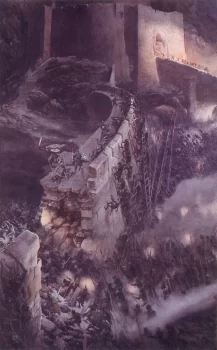 Battle of the Hornburg by Alan Lee
Battle of the Hornburg by Alan Lee
Again, for the uninitiated, a brief summary is in order. Following the disastrous events at the end of The Fellowship of the Ring, the Nine Walkers are split into three groups. Merry and Pippin, captured by a band of orcs, are dragged westward toward Isengard and Saruman. Frodo, with Sam insisting on accompanying, after Boromir’s attempt to seize the Ring, heads eastward toward Mordor and Mount Doom. Aragorn decides that Frodo and Sam might succeed on their own, but unless he, Legolas, and Gimli follow the other two hobbits, they will suffer torment and death.
The book’s first half, The Treason of Isengard, switches back and forth between Merry and Pippin’s travails, and Aragorn and his companions’ assorted adventures across Rohan. The two parties are reunited a week later after the return of Gandalf, the introduction of the Ents, great tree-like beings, and the Battle of the Hornburg (aka, the Battle of Helm’s Deep). The last is huge and murky in Peter Jackson’s film version, but on the page is tighter and far more tactically coherent.
The Ring Goes East, as I said, is the real heart of the trilogy. Frodo takes leave of his companions because he knows he must take the Ring to Mount Doom and that no one else can resist its malignant gravity. It also introduces Gollum/Sméagol. Gollum had been tracking the Nine Walkers from at least Moria, but he remained off stage. Now, he is captured and bound to Frodo after being made to swear on the Ring. Gollum, who calls the Ring his Precious, bore it for centuries. It twisted and hollowed him out, eating away at his mind and his soul. Now, he would do anything for its owner and, simultaneously, anything to repossess it.
Together, the trio cross the Dead Marshes, site of a great battle. Fought thousands of years before, images of the fallen, man, elf, and orc alike, linger on just below the surface of the marsh’s waters. Ghost lights flit over them, luring the unwary to their doom. Tolkien supposed that the battlefields of the Somme lived on in the Dead Marshes. He described how shell holes would be filled with water and the dead of both sides floated in them.
Clearing the swamps and finding Mordor’s main gate too formidable an obstacle, they head south to a secret way through the mountains Gollum claims can take them safely into Mordor. They meet their first men of Gondor, see an oliphaunt, witness the sallying forth of one of Sauron’s armies out of citadel so evil the ground around it is cursed, before starting on Gollum’s secret way. Things do not go well for any of them from there.
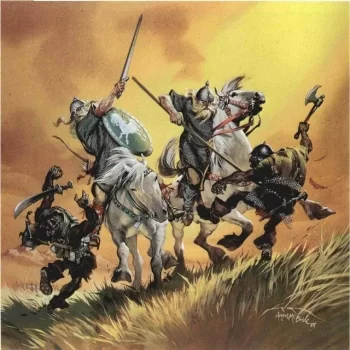 Riders of Rohan by Angus McBride
Riders of Rohan by Angus McBride
The Two Towers expands the reader’s vision of Middle-earth way beyond anything Tolkien displayed previously. The only human civilizations shown were the towns of Bree and Esgaroth. Now, we get to cross the expanse of the land of Rohan and meet its people, the Rohirrim. They been described as “Anglo-Saxon’s on horses,” which is reinforced with their Saxon-derived names such as Théoden, Éomer, and Éowyn.
Their horses were of great stature, strong and clean-limbed; their grey coats glistened, their long tails flowed in the wind, their manes were braided on their proud necks. The Men that rode them matched them well: tall and long-limbed; their hair, flaxen-pale, flowed under their light helms, and streamed in long braids behind them; their faces were stern and keen. In their hands were tall spears of ash, painted shields were slung at their backs, long swords were at their belts, their burnished shirts of mail hung down upon their knees.
It falls to the resurrected Gandalf to restore the king’s spirit so he can rouse his people and his forces against those of Saruman. Saruman once led the White Council against the resurgence of Sauron, but he came to betray them. Now he plans to conquer Rohan, Gondor’s only ally, and seize the Ring for himself.
And rouse the king, Gandalf does, which means we get one of Tolkien’s great epic moments. He doesn’t always show you the action in the books. We get the death of Boromir, Gandalf’s battle against the balrog, and the destruction of Isengard all second hand. Not this time. Instead, we get s brutal night battle against terrible odds and in harrowing detail, alleviated only a little by Gimli and Legolas’s banter over who’s killed more enemies.
It was now past midnight. The sky was utterly dark, and the stillness of the heavy air foreboded storm. Suddenly the clouds were seared by a blinding flash. Branched lightning smote down upon the eastward hills. For a staring moment the watchers on the walls saw all the space between them and the Dike lit with white light: it was boiling and crawling with black shapes, some squat and broad, some tall and grim, with high helms and sable shields. Hundreds and hundreds more were pouring over the Dike and through the breach. The dark tide flowed up to the walls from cliff to cliff. Thunder rolled in the valley. Rain came lashing down.
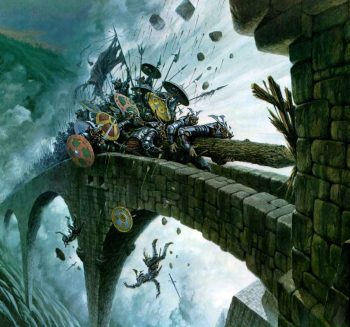 The Battle of Helm’s Deep by Darrell K Sweet
The Battle of Helm’s Deep by Darrell K Sweet
Arrows thick as the rain came whistling over the battlements, and fell clinking and glancing on the stones. Some found a mark. The assault on Helm’s Deep had begun, but no sound or challenge was heard within; no answering arrows came.
The assailing hosts halted, foiled by the silent menace of rock and wall. Ever and again the lightning tore aside the darkness. Then the Orcs screamed, waving spear and sword, and shooting a cloud of arrows at any that stood revealed upon the battlements; and the men of the Mark amazed looked out, as it seemed to them, upon a great field of dark corn, tossed by a tempest of war, and every ear glinted with barbed light.
Brazen trumpets sounded. The enemy surged forward, some against the Deeping Wall, others towards the causeway and the ramp that led up to the Hornburg-gates. There the hugest Orcs were mustered, and the wild men of the Dunland fells. A moment they hesitated and then on they came. The lightning flashed, and blazoned upon every helm and shield the ghastly hand of Isengard was seen. They reached the summit of the rock; they drove towards the gates.
Then at last an answer came: a storm of arrows met them, and a hail of stones. They wavered, broke, and fled back; and then charged again, broke and charged again; and each time, like the incoming sea, they halted at a higher point. Again trumpets rang, and a press of roaring men leaped forth. They held their great shields above them like a roof, while in their midst they bore two trunks of mighty trees. Behind them orc-archers crowded, sending a hail of darts against the bowmen on the walls. They gained the gates. The trees, swung by strong arms, smote the timbers with a rending boom. If any man fell, crushed by a stone hurtling from above, two others sprang to take his place. Again and again the great rams swung and crashed.
The Treason of Isengard was probably my favorite part of The Lord of the Rings when I was young. It’s got action and adventure and lots and lots of cool things. I remember me and my dad debating exactly what Orthanc and Meduseld looked like. Gandalf reappears and we learn about the palantír. The reunion of Merry and Pippin with Gandalf and company in Isengard is one of the funniest moments in the books. It all terrific, but it’s in The Ring Goes East, though, where the deepest themes of The Lord of Rings are developed.
Frodo and Sam march off toward Mordor knowing they probably won’t return, but they know it must be done. Defending what is right comes with a cost that leaves no one unchanged. It is too easy to fall in love with bloody deeds for themselves and forsake the things that might be lost.
In the middle of an attack by a band of Gondorian rangers on a force of enemy soldier, Sam meets the enemy up close for the first time.
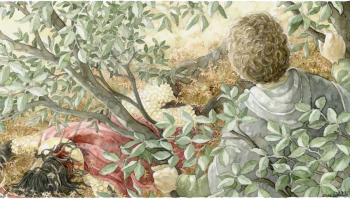 The Fallen Southron by Anke Eißmann
The Fallen Southron by Anke Eißmann
Sam, eager to see more, went now and joined the guards. He scrambled a little way up into one of the larger of the bay-trees. For a moment he caught a glimpse of swarthy men in red running down the slope some way off with green-clad warriors leaping after them, hewing them down as they fled. Arrows were thick in the air. Then suddenly straight over the rim of their sheltering bank, a man fell, crashing through the slender trees, nearly on top of them. He came to rest in the fern a few feet away, face downward, green arrow-feathers sticking from his neck below a golden collar. His scarlet robes were tattered, his corslet of overlapping brazen plates was rent and hewn, his black plaits of hair braided with gold were drenched with blood. His brown hand still clutched the hilt of a broken sword.
It was Sam’s first view of a battle of Men against Men, and he did not like it much. He was glad that he could not see the dead face. He wondered what the man’s name was and where he came from; and if he was really evil of heart, or what lies or threats had led him on the long march from his home; and if he would not really rather have stayed there in peace –
To take these words and give them to anyone other than an innocent gardener from the Shire is practically sacrilegious. I imagine this is how Tolkien must have felt on seeing his first dead Germans in the mud of the front. These words are at the core of the humanist heart of the books. War is a engine that sucks men in and grinds out corpses. It might be necessary, but it is horrible and not something to be cherished as many in Gondor have come to. Instead, the value of what is being defended must never be forgotten.
‘For myself,’ said Faramir, ‘I would see the White Tree in flower again in the courts of the kings, and the Silver Crown return, and Minas Tirith in peace: Minas Anor again as of old, full of light, high and fair, beautiful as a queen among other queens: not a mistress of many slaves, nay, not even a kind mistress of willing slaves. War must be, while we defend our lives against a destroyer who would devour all; but I do not love the bright sword for its sharpness, nor the arrow for its swiftness, nor the warrior for his glory. I love only that which they defend: the city of the Men of Númenor; and I would have her loved for her memory, her ancientry, her beauty, and her present wisdom. Not feared, save as men may fear the dignity of a man, old and wise.
In The Hobbit, Gollum was simply a twisted little monster below Goblin Town who riddled with Bilbo. Here, he’s become Sméagol again, a pathetic creature torn apart by possessing the Ring for so many years and the hold it still holds over him. Not much of Sméagol remains after five hundred years of possessing the Ring, and as he describes it, that part of himself went away a long time ago. When Sméagol is first captured, Frodo recalls the words of Gandalf about how Bilbo’s was stayed by pity and mercy from slaying Gollum and finds the same pity in his own heart. Come the third book, The Return of the King, even after Sméagol has betrayed them and tried to kill them, Sam can’t bring himself to kill him. He’s enough of a tragic creature that Tolkien is able to convince Frodo, and more importantly, the reader, that he might still be something worth saving.
Frodo and Sam are the most developed characters in the trilogy. Tolkien doesn’t go in for all that much interiority with any of the other characters in his books. From their conversations and from their thoughts, Frodo and Sam take on much more life than anyone else. Together, they get to express one of the most profound things in The Lord of the Rings.
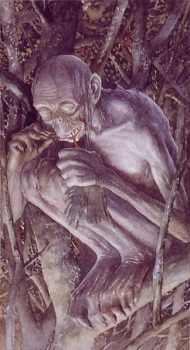 Gollum by Alan Lee
Gollum by Alan Lee
‘And we shouldn’t be here at all, if we’d known more about it before we started. But I suppose it’s often that way. The brave things in the old tales and songs, Mr. Frodo: adventures, as I used to call them. I used to think that they were things the wonderful folk of the stories went out and looked for, because they wanted them, because they were exciting and life was a bit dull, a kind of a sport, as you might say. But that’s not the way of it with the tales that really mattered, or the ones that stay in the mind. Folk seem to have been just landed in them, usually – their paths were laid that way, as you put it. But I expect they had lots of chances, like us, of turning back, only they didn’t. And if they had, we shouldn’t know, because they’d have been forgotten. We hear about those as just went on – and not all to a good end, mind you; at least not to what folk inside a story and not outside it call a good end. You know, coming home, and finding things all right, though not quite the same – like old Mr. Bilbo. But those aren’t always the best tales to hear, though they may be the best tales to get landed in! I wonder what sort of a tale we’ve fallen into?’
‘I wonder,’ said Frodo. ‘But I don’t know. And that’s the way of a real tale. Take any one that you’re fond of. You may know, or guess, what kind of a tale it is, happy-ending or sad-ending, but the people in it don’t know. And you don’t want them to.’
‘No, sir, of course not. Beren now, he never thought he was going to get that Silmaril from the Iron Crown in Thangorodrim, and yet he did, and that was a worse place and a blacker danger than ours. But that’s a long tale, of course, and goes on past the happiness and into grief and beyond it – and the Silmaril went on and came to Eärendil. And why, sir, I never thought of that before! We’ve got – you’ve got some of the light of it in that star-glass that the Lady gave you! Why, to think of it, we’re in the same tale still! It’s going on. Don’t the great tales never end?’
‘No, they never end as tales,’ said Frodo. ‘But the people in them come, and go when their part’s ended. Our part will end later – or sooner.’
 At the Cross Roads by Ted Nasmith
At the Cross Roads by Ted Nasmith
I love Sam’s realization that he personally is an appendix to a tale going back thousands of years. He’s reached this wonderful understanding that he’s in the middle of a story and then it suddenly occurs to him that he’s not even in his own story, but just one more leg on someone else’s. Of course all this gets mangled and bastardized in the movie.
Which brings me to Peter Jackson’s movie, which feels very much like someone other than Tolkien’s story. I’ll only bring up a few of the things that leave me enraged watching his The Two Towers. The easiest one is which two towers the title refers to. The book’s title refers to Orthanc and Minas Morgul. Instead, Jackson has Saruman deliver a line about a new power made of the union of two towers, by which he means Orthanc and Barad Dur. I don’t know if I can say it’s an important thing, but I can say it’s an annoying thing.
Aside from Aragorn falling off a cliff, more bad jokes — dwarf tossing (again!), bad soup, and others — and buffoonishness from Merry and Pippin, there’s the case of Bad Faramir. In the book, Faramir is a throwback to the noblest Men of the West. Unlike his brother Boromir, he fights for the good things, not for the accolades or the desire to perform heroic deeds. He is not tempted by the Ring and helps the hobbits on their way.
Jackson’s Faramir, like Aragorn before him, can’t simply be a hero. He must be flawed and learn something or other before he can achieve his heroic status. That neither he, nor Boromir, are fair skinned with dark hair only makes matters worse.
I’m not that thrilled with how the Battle of Helm’s Deep is handled in the film. In the book, Théoden brings his forces to the fortress for clearly laid out strategic reasons. Here, it’s made out to be some sort of foolish, poorly thought out action. Aragorn argues with him about sending out messengers for aid, something no one in the book would imagine saying for a moment.
The battle never seems as desperate or grim as Tolkien makes it out to be (Haldir, the elf with the five o’clock shadow, getting killed doesn’t count because he’s barely a character). I struggle to image Orlando Bloom’s Legolas acting like this:
He climbed up and found Legolas beside Aragorn and Éomer. The elf was whetting his long knife. There was for a while a lull in the assault, since the attempt to break in through the culvert had been foiled.
‘Twenty-one!’ said Gimli.
‘Good!’ said Legolas. ‘But my count is now two dozen. It has been knife-work up here.’
I can’t bring myself to say anything else about the movie. Yes, we do get to see the Ents destroy Isengard, but even that’s not as cool looking as it’s described in the book. I’m so sick and tired of whining Frodo and the scene with the Ring Wraith and then him threatening Sam makes me nuts. I just tried to watch the animated War of the Rohirrim and I think something broke in my head.
I guess the only thing to do now that I’ve finished The Lord of the Rings is to go to The Silmarillion, The Hobbit, or….Bored of the Rings. Whichever I choose, it’s guaranteed to wash away some of the pain of Jackson’s movie.
Half a Century of Reading Tolkien: Part One
Half a Century of Reading Tolkien: Part Two – The Fellowship of the Ring by JRR Tolkien
Fletcher Vredenburgh writes a column each first Sunday of the month at Black Gate, mostly about older books he hasn’t read before. He also posts at his own site, Stuff I Like when his muse hits him.
There, Wolves: Part II
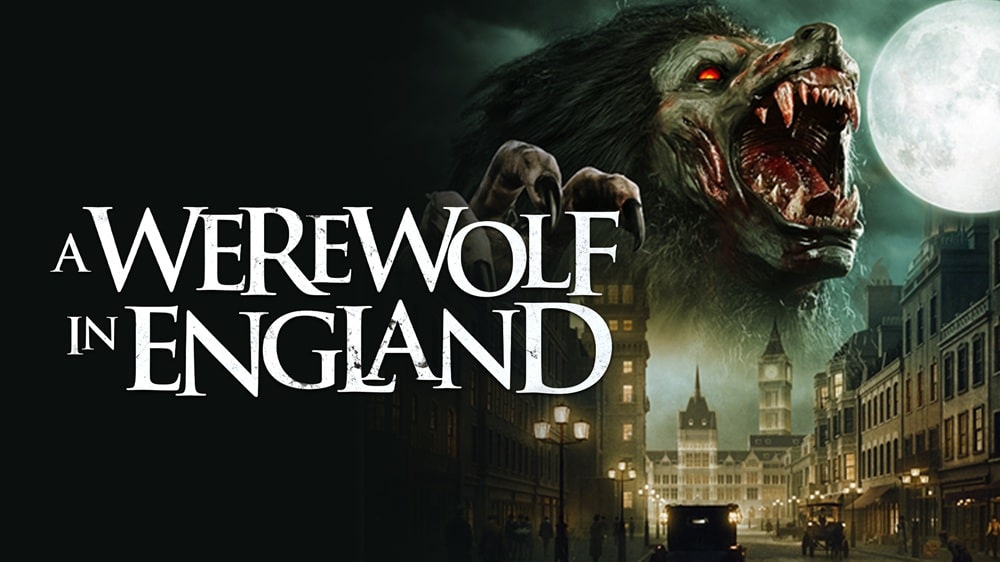 A Werewolf in England (Dark Temple Motion Pictures, 2020)
A Werewolf in England (Dark Temple Motion Pictures, 2020)
A 20 film marathon of werewolf movies I’ve never seen before.
As usual, the films must be free to stream.
I’ve got a bad feeling about this.
A Werewolf in England (2020) PrimeMan or beast? A bunch of hairy honkers.
Howlin’ good time? Hot on the heels of Werewolves Within comes another horror comedy, although this one doesn’t come close to succeeding. It starts well enough, with a title card font reminiscent of the best Bray Studios films, and some gravelly voiced dialects, but it soon regresses into a two-note gag reel of chamber pots and the contents of chamber pots.
Now, I like a good fart or poo joke as much as the next man, but the over-reliance on potty humor soon outstayed its welcome, despite a double dip into demonic diarrhea. There were moments that put me in mind of Motel Hell, but in the end the production was hampered by over saturation (seriously, filter that shit in post), poor sound design and strangely choreographed werewolves.
The beasts, more cuddly than terrifying, could have been really effective with lower lighting and more sparing framing. Oh well — it looked like everyone had fun, and it does feature the line, “I feel a tinglin’ in me nether giblets.”
6/10
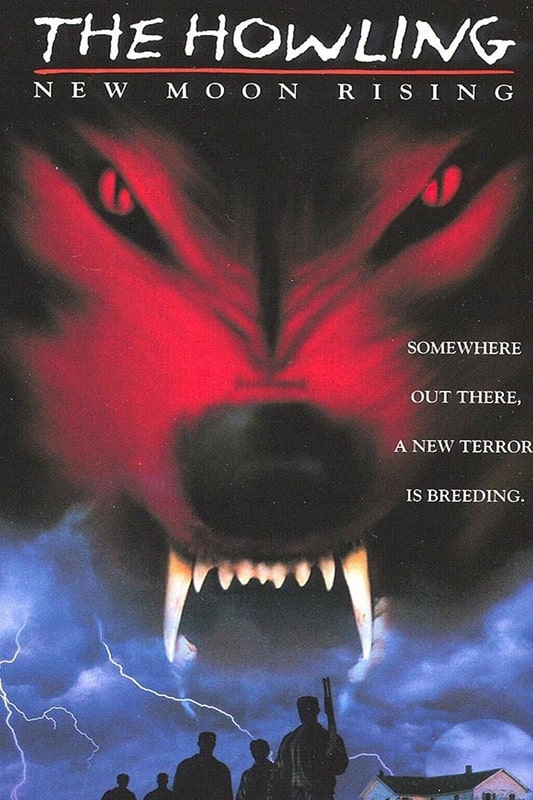
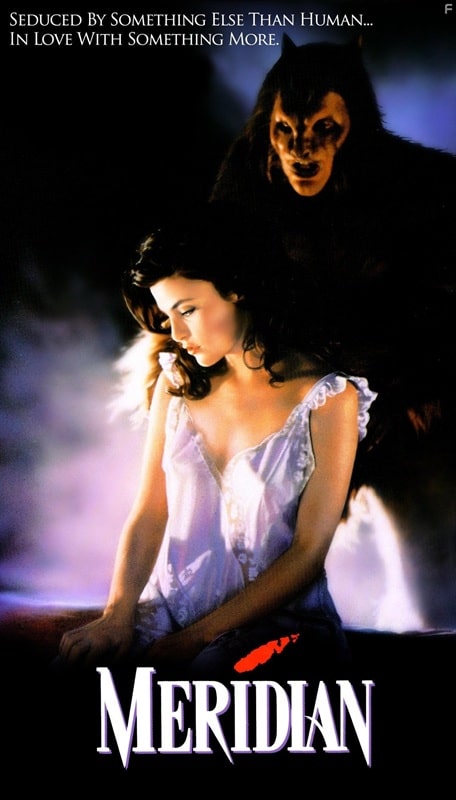
Howling VII: New Moon Rising (New Line Home Video, October 17, 1995)
and Meridian (Full Moon Features, April 13, 1990)
Man or beast? Rubbish practical/CG hybrid for all of 30 seconds at the end.
Howlin’ good time? Good people, if you’ve been reading these reviews, you’ll know I’ve watched some terrible films. You’ll also know that the worst thing a movie can do, in my opinion, is be boring. Forget the fact that this is horribly made, awfully acted, and weaves in footage from the last two films in an attempt to make sense of the story. The first hour of this mess is just unfunny bar regulars line dancing to country music while some bullshit ADR is shoveled on top of the steaming pile of plot. I honestly lost the will to live during this one. Settled for chewing my eyes out.
0/10
Meridian (1990) TubiMan or beast? Nice, practical, beast… wolf… thing.
Howlin’ good time? It’s a Full Moon feature, directed by Charles Band himself and although I think he’s a better producer, this is a nice looking film, suitably gothic for the subject matter. Meridian stars Sherilyn Fenn (and yes, I was a fully carded member of the Cult of Fenn in 1990) in a twist on the Beauty and the Beast story. In fact, it would have been a traditional, romantic ghost/beast story, if not for the unsavoury date rape that kicks off the whole affair.
The beast itself is a curious design, beautifully created by Greg (Lost Boys, Dracula) Cannom, who was definitely enjoying his ‘high brow’ phase. The prosthetics are great, and the body suit is well done; the huge hairy mass on its back is just one of a pair of extraordinary werewolf humps in the film. An interesting watch for purveyors of circus acts, nefarious twins and early 90s bosoms.
7/10
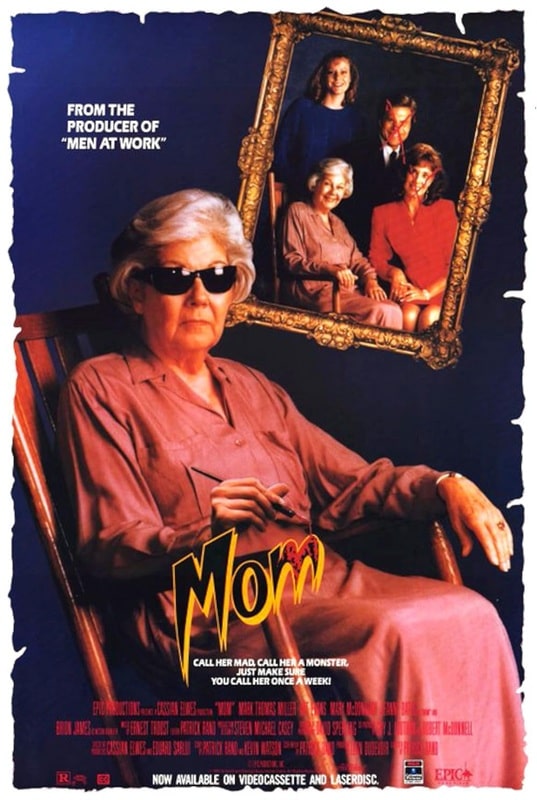
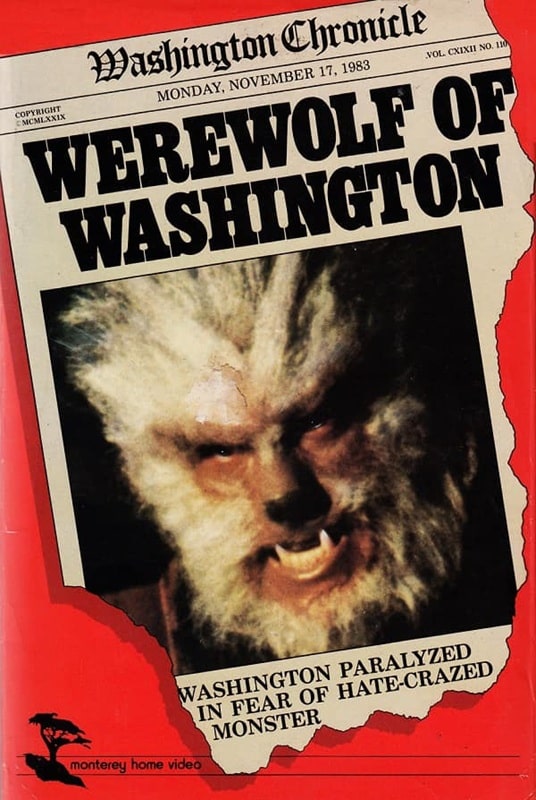
Mom (Epic Productions, June 13, 1991) and Werewolf of Washington (Diplomat Pictures, 1973)
Man or beast? Goofy were-thing.
Howlin’ good time? A 1990s horror film that is so 1990s it hurts. It starts well enough, with the wonderful Brion James as a shady, yellow-eyed drifter being aggressively creepy, and there’s a potentially excellent story to be had when our hero has to deal with his dear old mom turning into a werebeast and eating winos, but it’s not quite as exciting as I had hoped for. The creature itself is only seen in head and shoulder flashes and, although the mid-transformation make up is cool, the final creature looks goofy as all hell — we are talking Rawhead Rex goofy.
Fair to middling.
6/10
Werewolf of Washington (1973) TubiMan or beast? Hairy faced fella.
Howlin’ good time? It’s a scandal that I haven’t seen this before, but I’ve corrected that oversight. Not what I was expecting, this is a political satire wrapped up in a traditional lycanthrope yarn and it’s played for laughs. Skewering Nixon and Watergate, in this flick Dean Stockwell superbly grimaces and gurns as he changes each full moon and makes a meal of the president’s rivals. It’s basically All the President’s Wolfmen. Some genuinely funny moments (a witty script) and remarkable lapses into cinema verité elevate this hokey, bloodless romp into a film that I suspect I shouldn’t have enjoyed as much as I did.
7/10
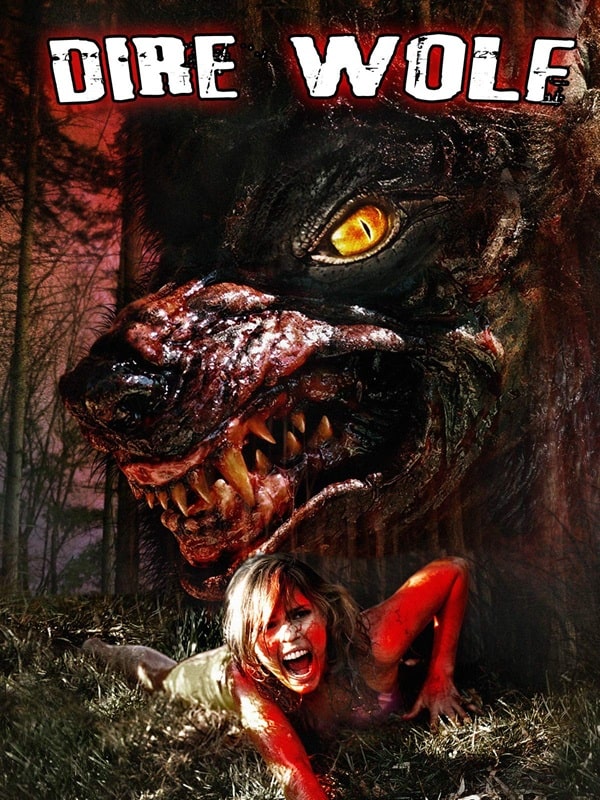 Dire Wolf (Baby Steps Entertainment, 2009)
Dire Wolf (2009) Tubi
Dire Wolf (Baby Steps Entertainment, 2009)
Dire Wolf (2009) Tubi
Man or beast? Wolf/human hybrid.
Howlin’ good time? Bit of a cheat for no. 13, as it’s not strictly a werewolf, but a lab experiment gone wrong. Nothing remarkable about it; it’s typical SyFy fare, a couple of has-beens surrounded by lacklustre actors in a daft plot, with a surprising amount of practical gore. It’s instantly forgettable. However, it did prompt an extraordinary dive into the career of Fred Olen Ray, whom I only really knew for Alienator and Hollywood Chainsaw Hookers. I’m linking the Wikipedia page for his filmography here, as it’s quite the rabbit hole.
Anyhoo – 5/10
Previous Murkey Movie surveys from Neil Baker include:
There, Wolves: Part I
What a Croc
Prehistrionics
Jumping the Shark
Alien Overlords
Biggus Footus
I Like Big Bugs and I Cannot Lie
The Weird, Weird West
Warrior Women Watch-a-thon
Neil Baker’s last article for us was There, Wolves: Part I. Neil spends his days watching dodgy movies, most of them terrible, in the hope that you might be inspired to watch them too. He is often asked why he doesn’t watch ‘proper’ films, and he honestly doesn’t have a good answer. He is an author, illustrator, outdoor educator and owner of April Moon Books (AprilMoonBooks.com).
The Quiet Mindfulness of Page Turning and 8 Transformative Novels
In this LitStack Rec, let’s explore the myriad benefits of page turning and its potential…
The post The Quiet Mindfulness of Page Turning and 8 Transformative Novels appeared first on LitStack.
SHROUD by Adrian Tchaikovsky
Cover Reveal: Space Ships! Ray Guns! Martian Octopods!: Interviews with Science Fiction Legends, edited by Richard Wolinsky
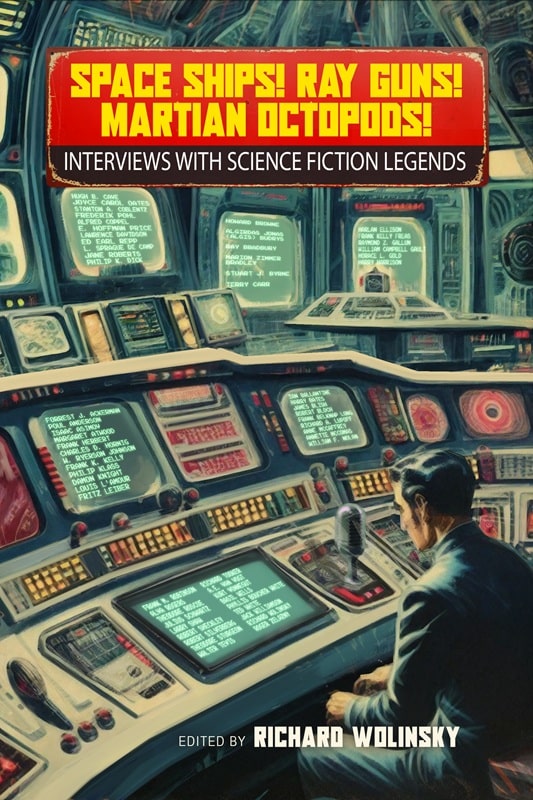 Space Ships! Ray Guns! Martian Octopods!: Interviews with Science Fiction Legends (Tachyon Publications, September 2, 2025). Cover by Yoshi Vu
Space Ships! Ray Guns! Martian Octopods!: Interviews with Science Fiction Legends (Tachyon Publications, September 2, 2025). Cover by Yoshi Vu
At Black Gate, we’re all about science fiction legends. Specifically, science fiction legends who appeared in paperback in spinner racks in the 70s and 80s. Or pulp magazines. Or wrote adventures at the dawn of the role playing industry. You know what, forget all that. We’re not picky.
What makes a true science fiction legend? This is the sort of thing that’s hotly debated on social media, and at science fiction conventions, and in lengthy blog posts titled “Towards a New Science Fiction Canon, Because Yours is Old and Stupid.” But recently, public opinion has shifted. To be a science fiction legend, the most important criteria is that your name looks good in green font on a 50s CRT monitor, preferably in a cool underground bunker. Exactly like the cover of Space Ships! Ray Guns! Martian Octopods!: Interviews with Science Fiction Legends, the upcoming book from Richard Wolinsky and Tachyon Publications.
I’ve spent long hours staring at this cover (by the marvelously talented Yoshi Vu), and the more I do, the more I’m convinced I’m right. Just look at those names. Look at how cool they are! Roger Zelazny, Theodore Sturgeon, Robert Sheckley, Jack Williamson, Fritz Leiber, Damon Knight, Poul Anderson, Isaac Asimov, Anne McCaffrey, William F. Nolan, Terry Carr, Frederik Pohl. Right now you’re shaking your head, but you know I’m right.
Those glowing green names don’t just constitute a comprehensive list of true science legends. Coincidentally, they also happen to be included in this fabulous book of interviews. Don’t take my word for it; here’s the press release to show how right I am.
In this collection of candid interviews, more than fifty legendary authors swap fascinating — and sometimes controversial — anecdotes about the Golden Age of science Fiction (1920–1960). With such guests as Ray Bradbury, Robert Bloch, Harlan Ellison, Philip K. Dick, Isaac Asimov, Margaret Atwood, Fritz Leiber, Frank Herbert, and many more, here are the wild personalities, sparks of contention, and vivid imaginations that made science fiction thrive.
Today, depictions of aliens, rocket ships, and awe-inspiring, futuristic space operas are everywhere. Why is there so much science fiction, and where did it come from? Radio producer and author Richard Wolinsky (Probabilites) has found answers in the Golden Age of science fiction.
Wolinsky has interviewed a veritable who’s who of famous (and infamous) science fiction publishers, pulp magazines, editors, cover artists, and fans. The interviews themselves, which aired on the public radio show, Probabilities, span more than twenty years, from just before the release of Star Wars through the dawn of Y2K. The result, Space Ships! Ray Guns! Martian Octopods!, is ultimately a love letter to fandom.
See? I told you.
I’m not familiar with Richard Wolinsky, but it’s clear that I should be. He cohosted Probabilities, a half-hour public radio program devoted to science fiction, mystery, and mainstream fiction, which aired in San Francisco for nearly twenty years, from 1977 – 1995. After he took the program solo in 2002 he renamed it Bookwaves, and that incarnation is still running.
Space Ships! Ray Guns! Martian Octopods!: Interviews with Science Fiction Legends belongs on every serious science fiction bookshelf. It definitely belongs on mine, anyway.
It will be released from Tachyon Publications on September 2, 2025. It is 256 pages, priced at $18.95 in paperback and $11.00 in digital formats. Get more details and order copies directly from the publisher here.
The Enchanted Greenhouse - Early Book Review
 The Enchanted Greenhouseby Sarah Beth Durst
The Enchanted Greenhouseby Sarah Beth DurstWhat is it about:New York Times bestselling author Sarah Beth Durst invites you to her new standalone novel nestled on a far-away island brimming with singing flowers, honey cakes, and honeyed love. The hardcover edition features beautiful sprayed edges.
Terlu Perna broke the law because she was lonely. She cast a spell and created a magically sentient spider plant. As punishment, she was turned into a wooden statue and tucked away into an alcove in the North Reading Room of the Great Library of Alyssium.
This should have been the end of her story . . . Yet one day, Terlu wakes in the cold of winter on a nearly-deserted island full of hundreds of magical greenhouses. She’s starving and freezing, and the only other human on the island is a grumpy gardener. To her surprise, he offers Terlu a place to sleep, clean clothes, and freshly baked honey cakes—at least until she’s ready to sail home.
But Terlu can’t return home and doesn’t want to—the greenhouses are a dream come true, each more wondrous than the next. When she learns that the magic that sustains them is failing—causing the death of everything within them—Terlu knows she must help. Even if that means breaking the law again.
This time, though, she isn’t alone. Assisted by the gardener and a sentient rose, Terlu must unravel the secrets of a long-dead sorcerer if she wants to save the island—and have a fresh chance at happiness and love.
Funny, kind, and forgiving, The Enchanted Greenhouse is a story about giving second chances—to others and to yourself.
What did I think of it:*I was lucky enough to get a digital Advance Reader Copy of this book*
This is a standalone set in the same world as The Spellshop, but anyone who read and loved The Spellshop will recognize who Terlu is, and so needs to read this! New to this world? You can totally read and love this book without reading the Spellshop first, but believe me: you need both these books, they're both awesome!
I liked Terlu, and had a lot of sympathy for her, but then the grumpy gardener Yarrow was introduced, and just Wow! He and I have a lot in common I have to confess. From that point on I so rooted for the both of them,(maybe a little bit more for Yarrow) that they would succeed in saving the greenhouses.
I feared one of my least favorite tropes would happen in this book, and it did, but Durst managed to write it in a way that didn't make me want to puke like I usually do with this particular trope (which I will name the 'Shiny Happy People' trope to not spoil too much).
So with a certain trope handled in the best was possible this was just as beautiful and emotional a read as The Spellshop. I loved reading about the wonders in the greenhouses, and learn more about the world Durst created. There's tons of beauty and whimsy, next to a really emotional story that also has lots to smile about.
You bet I will impatiently wait for the release and get my trotters on the hardcover to place it next to The Spellshop. And if there's to be more books: I'm going to hope it will be about certain characters who have a small role in this book.
Why should you read it:It's a great, cozy Fantasy with a wonderfully grumpy gardener.
Expected publication: July 15, 2025 by Bramble
Goth Chick News: Time Stands Still in Pause: John Carpenter’s Latest Sci-Fi Horror Comic
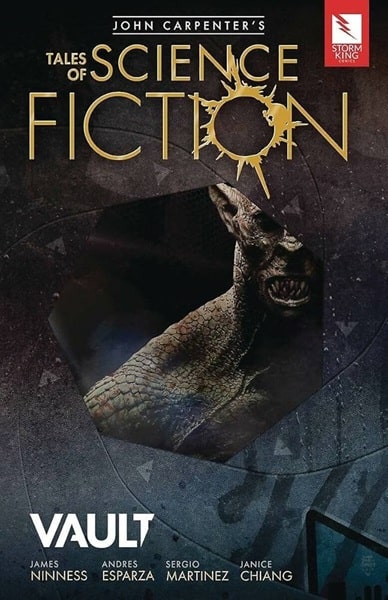
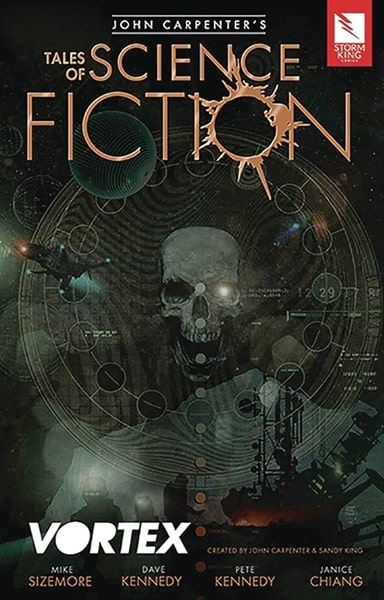
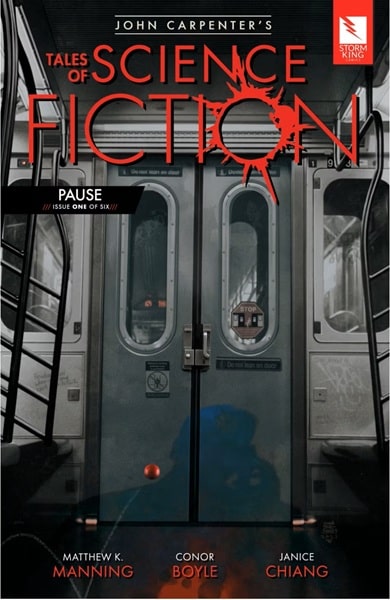
John Carpenter’s Tales of Science Fiction: Vault (June 2018), Vortex
(October 2018), and issue #1 of Pause (February 26, 2025
Storm King Comics was founded in 2012 by legendary filmmaker John Carpenter and his wife of thirty-five years, producer Sandy King. Together, they are known for delivering stories of horror, science fiction, and the supernatural, with series like John Carpenter’s Tales of Science Fiction and John Carpenter’s Tales for a HalloweeNight. Combining Carpenter’s cinematic style with the visual storytelling of comics, Storm King Comics offers fans immersive experiences that have cemented its reputation in the comic book industry.
I was first introduced to Storm King Comics by the grand dame herself, Sandy King, when I met her in 2016 at C2E2. Since then, I have collected all the issues from Tales for a HalloweeNight as well as Asylum which was my first exposure to the great stories that come out of Storm King. And though I am not a sci-fi girl strictly speaking, I love a good crossover, which this week’s launch seems to be.
For a bit of background, John Carpenter’s Tales of Science Fiction launched in 2018 with its inaugural story Vault, telling the tale of a moon-bound crew who discover an alien vessel with English markings. Since that time there have been eleven total installments and this week the series returns with installment twelve, entitled Pause.
Here’s what you have to look forward to…
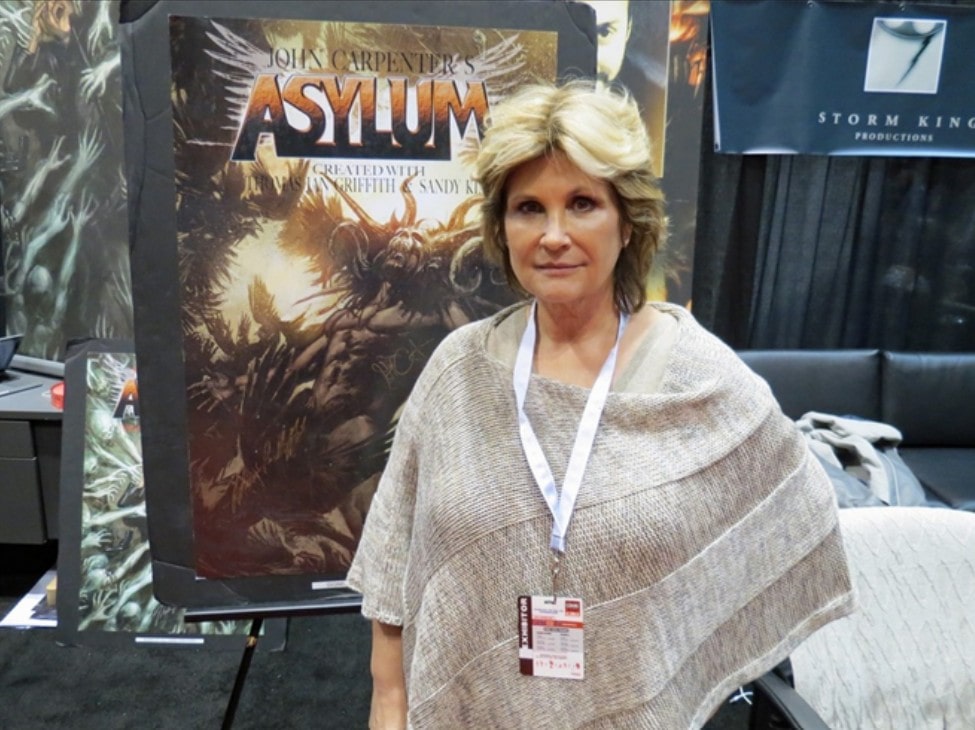 When I met Sandy in 2016
When I met Sandy in 2016
Picture this: you’re the only one not frozen in a world where time has stopped. You could lounge in a luxury Manhattan penthouse while its owner stands motionless nearby. You could feast on gourmet meals, perfectly hot and untouched, at high-end restaurants.
But what if you could bring others back to life with just a touch? Would you break the silence for companionship — or keep this frozen paradise all to yourself? The possibilities seem endless, but in a world like this, making the wrong move could unpause more than you bargained for…
Check out the trailer set to “Beyond the Gallows” from Carpenter’s latest album, Lost Themes IV: Noir.
Pause is written by Matthew K. Manning (Batman/Teenage Mutant Ninja Turtles Adventures), illustrated by Conor Boyle (Judge Dredd), and lettered by Janice Chiang.
Issue #1 of the six-issue limited series is available today, with new issues arriving monthly through August.
Review of Mother of Rome by Lauren J. A. Bear
As a Bookshop affiliate, I earn from qualifying purchases. Book Description: A powerful and fierce reimagining of the earliest Roman legend: the twins, Romulus and Remus, mythical founders of history’s greatest empire, and the woman whose sacrifice made it all possible. The names Romulus and Remus may be immortalized in map and stone and chronicle, but their mother exists only as a preface to her sons’ journey, the princess turned oath-breaking priestess, condemned to death alongside her children. But she […]
The post Review of Mother of Rome by Lauren J. A. Bear first appeared on Fantasy Cafe.Spotlight on “Twist” by Colum McCann
Twist by Colum McCann is a propulsive novel of rupture and repair in the digital…
The post Spotlight on “Twist” by Colum McCann appeared first on LitStack.
On McPig's Wishlist - The Serpent Called Mercy
 The Serpent Called Mercyby Roanne Lau
The Serpent Called Mercyby Roanne LauThe Witcher meets Squid Game in this Malaysian Chinese-inspired epic fantasy novel where a debt-ridden slumdog joins an illegal monster-fighting arena for some fast coin, but quickly learns the most dangerous beasts are outside the ring, by debut author Roanne Lau
Lythlet and her only friend Desil are shackled to a life of debt and poverty that she fears they will never escape. Desperate for money, they sign up as arena combatants who fight sun-cursed beasts in the seedy underworld of the city.
Match-master Dothilos is initially enamored of Desil’s brawling reputation, but after seeing Lythlet lead the pair to triumph with her quick cunning, he takes her under his wing, scorning Desil. Ambition takes root in Lythlet’s heart as a life of fame and wealth unfolds in her imagination.
But Lythlet isn’t the only one out for coin and glory, and she soon finds herself playing an entirely different game—a game of politics and deception. As the cost of her ambition grows, she will have to decide if sacrificing her honor, and only friendship, is worth the chance to shape her own fortune.
A whirlwind of blood-pounding battles as characters grapple with their choices in the face of wealth and financial security, The Serpent Called Mercy's heart is the underlying, steadfast friendship between its protagonists.
Expected publication: March 25, 2025

Recent comments